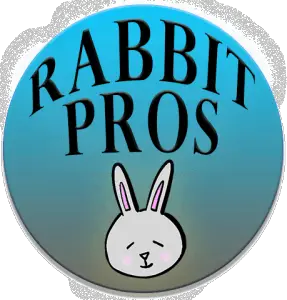

Rabbit Sheds – The Ultimate Outdoor Bunny Hutch With Pictures
Disclosure: We may earn money or products from the companies mentioned in this post.
Rabbit sheds seem to be quite popular in England but they haven’t caught on in America and the rest of the world. However, I think these ultimate outdoor rabbit cages should become more popular worldwide.
Table of Contents
What Is A Rabbit Shed
A rabbit shed is a very large rabbit outdoor rabbit cage that is often made by converting a garden shed into a bunny house. Rabbit sheds are usually large enough that you can visit your bunny inside their home.
What Is A Rabbit Run
An outdoor rabbit run is a large, secure wire outdoor structure for a pet rabbit where they can get exercise and play. Rabbit runs can be of any size, as long as they are large enough for all bunnies inside to run, jump, and play.
The advantages of a rabbit shed include:
- Being able to play with your bunny in their home where they are most relaxed.
- Allowing your rabbit to have a bunny safe room to roam freely.
- Offers the ultimate weather protection for outdoor rabbits.
- Enough room for lots of rabbit toys and obstacles to keep your bunny entertained.
- Offers the best protection from outdoor predators.
- Gives your bunny his own home, instead of him living in your home.
- Giving your bunny the ultimate feeling of safety in an outdoor environment.
- Gives you comfort knowing your outdoor bunny is safe and secure.
- You can easily have multiple bunnies share a rabbit shed.
- Rabbit sheds contain bunny messes and make cleanup easier.
- You can safely add electricity to a rabbit shed to provide light, heat, and even air conditioning.
- It can be a beautiful addition to your backyard.
- It’s a great conversation piece!
Disadvantages Of A Rabbit Shed
- Rabbit sheds are big.
- They are expensive to build.
- They are nearly impossible to buy premade.
Rabbit Shed Ideas
I asked a bunch of my rabbit friends to share pictures of their rabbit sheds so you could become more familiar with what I consider the best outdoor rabbit cage.
We’ll start with some of the more basic designs first then work towards the fanciest ones. To be clear, these are all amazing setups!
P.S. If you have a rabbit shed that you’d like to share with your rabbit friends, send me an email at [email protected] .
We are considering offering a pre-build rabbit shed. Keeping in mind that it would be pricy, would you be interested in hearing more about it if we decide to move forward? If so, signup for our email list and let us know in the comments below that there is a demand for prebuild rabbit sheds.
1. The Rabbit Shed Within The Rabbit Run
These rabbit shed pictures are courtesy of Dawn F. You are going to love her setup.
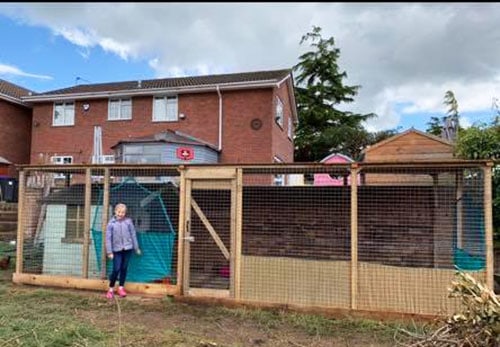
First notice that her rabbit shed sits entirely inside of a huge bunny run. These are some safe and secure bunnies!
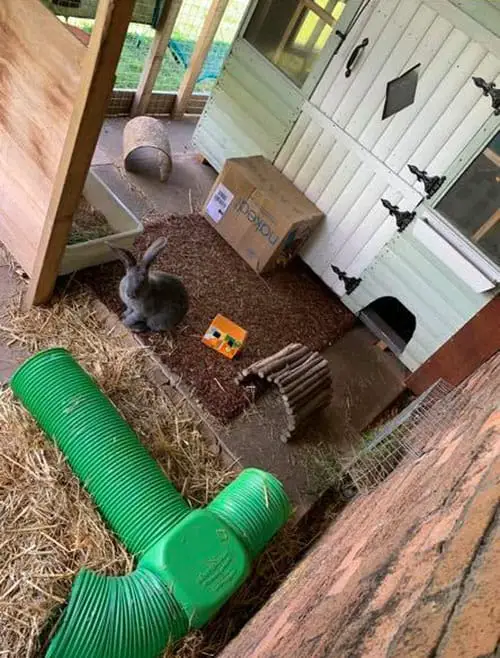
Now we take a look inside the rabbit run and you see the ‘bunny door’ into the shed portion of this lucky bunny’s home.
Also, notice all of the great toys to keep everyone entertained. You’ll also notice the rabbit litter box right out there in the opening where sweeping up messes is a breeze.
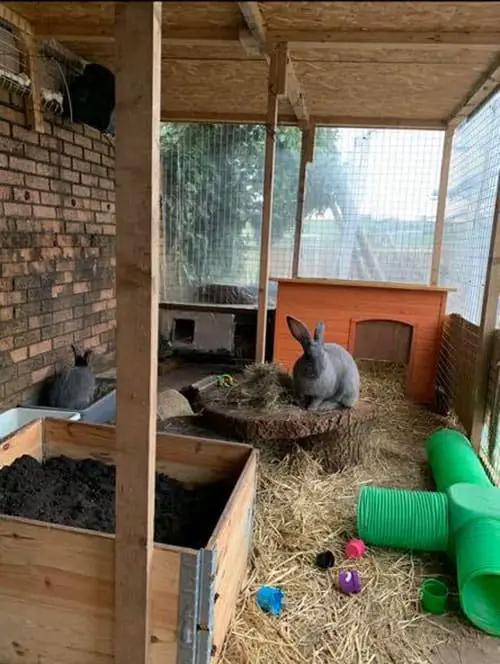
With this view you’ll see even more bunny engagement toys.
Check out the digging box with real dirt. You wouldn’t do that inside your home but inside of the Rabbit Shed home, it’s great!
Also notice a few more free-access rabbit hutches in the background to give these bunnies endless choices of places to relax.
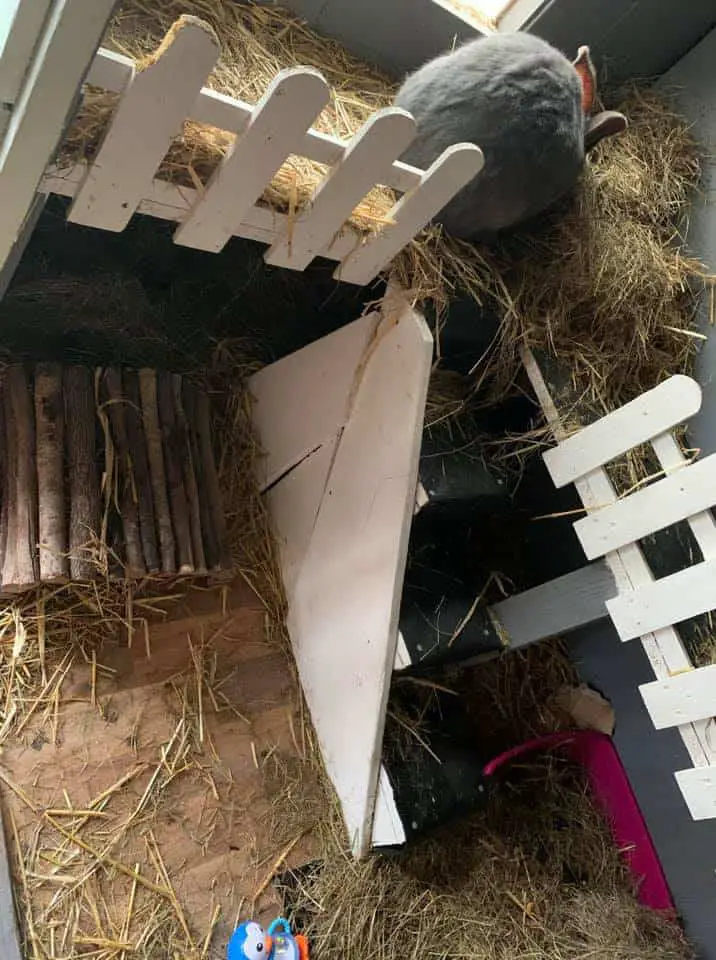
This is a peek inside of the shed. Notice the stairs up to a loft with side rails and a window to look out at the world.
These bunnies are living a great life!
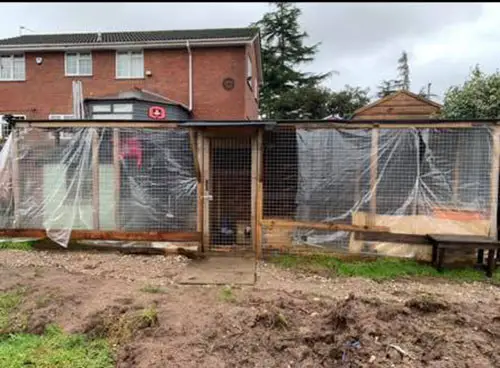
This picture just shows how Dawn wraps the outdoor run in plastic in the winter to give her bunnies even more protection.
Lots of people with rabbit sheds wouldn’t go to this extra effort, especially given that the bunnies have so many areas protected from the weather.
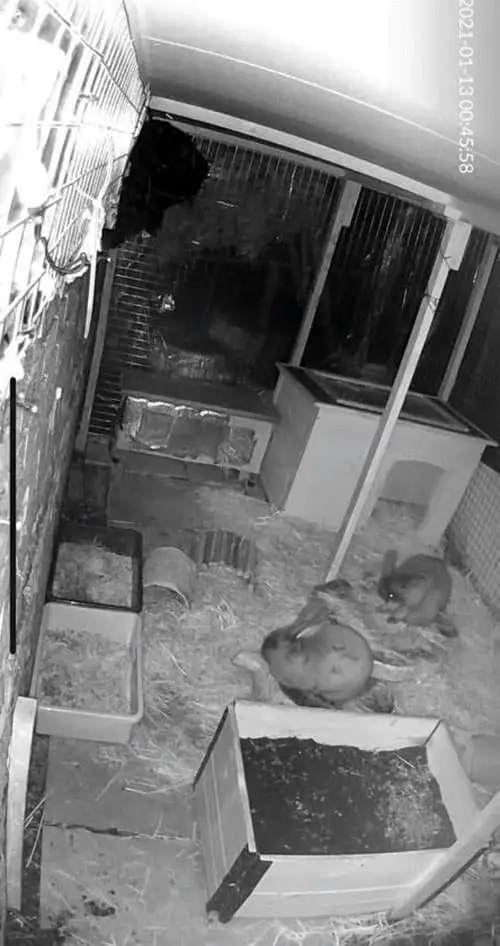
Finally, Dawn shared a screenshot from her Bunny Cam which she installed so so she can check on her cuties’ home from inside her own home…even at night!
2. The Rabbit Shed With A Hutch Inside
This is just a single picture shared by Chloe. It’s neat because it shows a different type of rabbit shed.
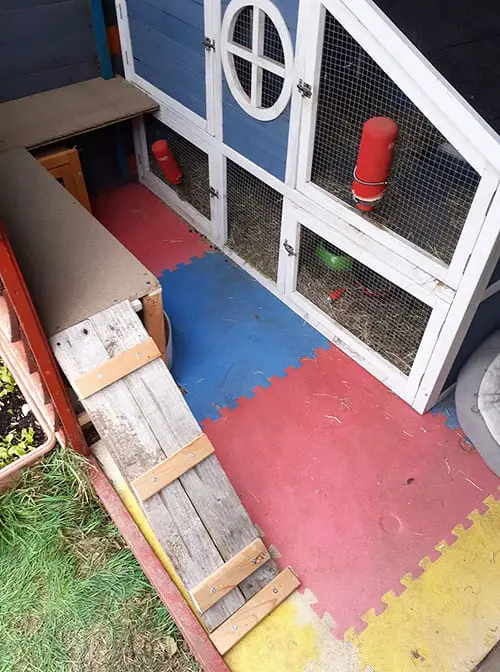
That’s the inside of a rabbit shed with the door open. Notice the hutch inside the shed to give them a smaller safe space while still having free run of their whole shed.
I think it’s worth noting the hard foam mats that are on the floor to soften things up for the bunnies. Notice how they are not all chewed up! I personally believe that buns that have lots of freedom and things to explore/play with are much less likely to chew up things.
I’m pretty sure that they have a temporary rabbit run that they can put up to let the buns have outdoor time while still having access to their home.
3. The Brand New Rabbit Shed
Faye shared these pictures of her brand new rabbit shed with us. It’s very cool to see because she really did start with a nice shed and just converted it into a dream rabbit shed.
This is going to be one pampered bunny with a great rabbit home.
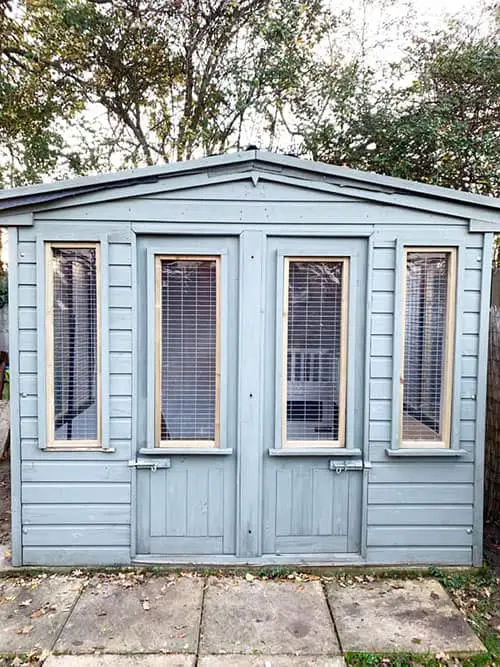
What a pretty little shed! It’s going to make an amazing rabbit shed.

Looking in from the open door, we see a small bunny bedroom and a huge bunny loft. But wait for it…

The loft has giant bunny windows!
Also check out that ramp up to the loft. That’s living in style.
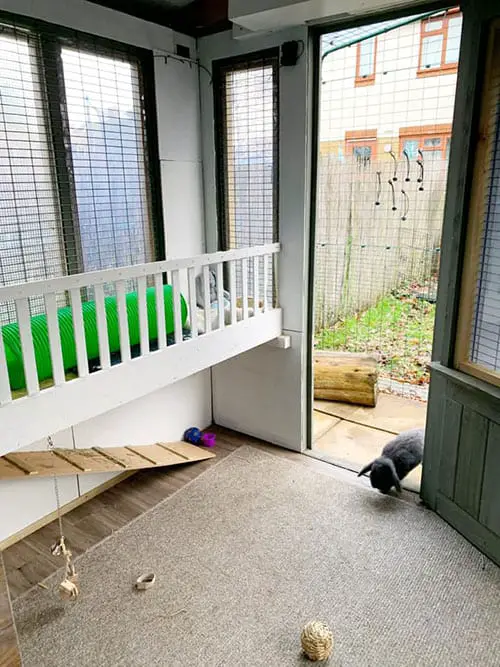
And here comes the lucky bunny checking out his new digs for the first time.
Also notice that they have created a protected outside area with some fencing. This lucky bunny will be safe and secure inside at night, but during the day he’ll have free access to the great outdoors!
4. The Rabbit Shed With A Lawn
Isabelle shared pictures of both her old rabbit shed and her new one with all of us. She did mention that she moved, but I think the design changes she made are really interesting.

This is Isabelle’s old rabbit shed and outside play area. It’s beautiful and so spacious.
I like the big pavers nears the edges of the run with open areas in the middle. That has to help keep the bunnies from digging out yet still gives the buns access to grass and dirt.

This is her new rabbit shed and outside bunny run.
I love how she split the outside area into two separate areas. I have to assume that this has a few great advantages.
First, you can keep bunnies separated if necessary because of either babies or just bunnies that don’t get along really well.
Second, I love that you could let the grass grow in one play area for a few weeks then switch the play areas. With a rotation of grass areas, your bunnies could have wonderful tall grass to play in and eat all summer long. Brilliant!
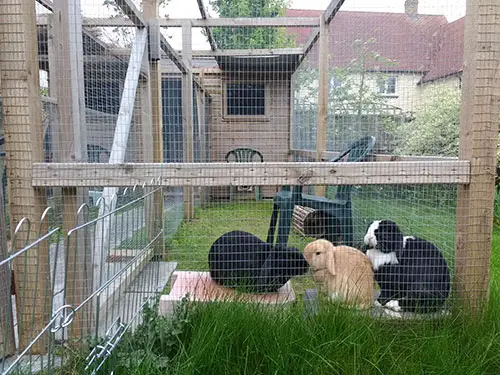
Look at those happy buns perched high over their beautiful grass. That’s a good life.
Also, note all of the human chairs in the rabbits shed and outdoor play area . Can’t you just imagine hanging out with your bunnies? I can picture myself just setting out there reading a book and enjoying hanging out with the rabbits.
5. Shorty’s Rabbit Shed & Outdoor Rabbit Run
This rabbit shed breaks from the norm of the others shared so far. Keri shared this picture of her smaller rabbit shed.
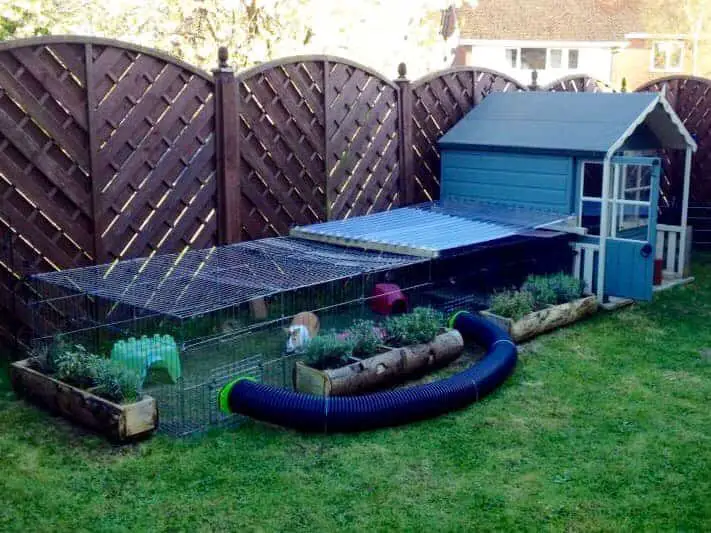
Isn’t that an adorable rabbit shed?
While you’re not going to be hanging out inside your bunny rabbits’ outdoor home, they still have an amazing place to live.
The advantage to a smaller outdoor rabbit shed like this one is that it’s going to be less expensive. The downside is that it’s harder to get in there to play or cleanup.
6. The Rabbit Shed With Movable Rabbit Tractors
Rachel shared a couple of pictures of her crazy cook rabbit shed setup. She is definitely thinking outside of the box.
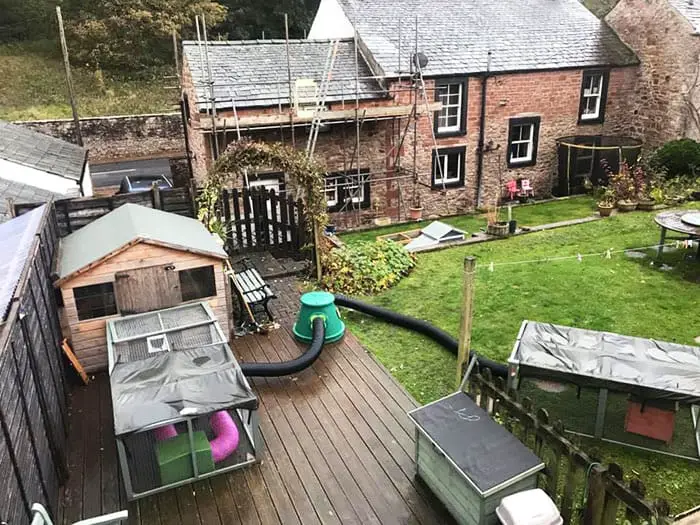
You’ll see the actual rabbit shed on the deck on the left-hand edge of this picture. From there the bunnies can go out into another low bunny run also on the deck.
That bunny run is connected by bunny-sized tubing to another run out on the grass.
With this setup, you can move that second rabbit run around. If you added some wheels to that cage, you’d have a rabbit tractor and could let your bunnies manicure your whole yard with daily moves of the cage.
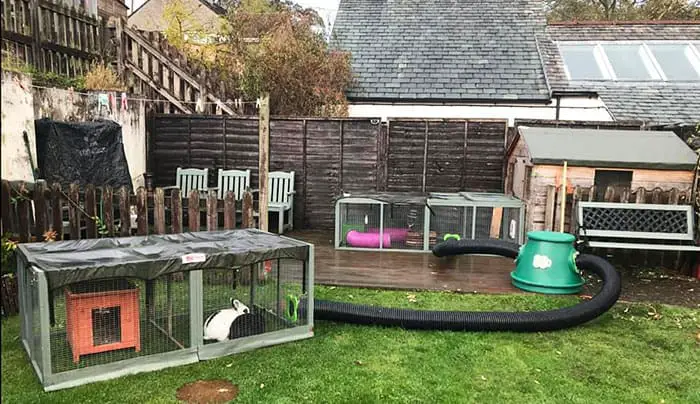
Check out the small hutch in the cage on the grass. Even when out here in the yard, if some predator were to fly over the rabbit still has a safe place to seek cover.
7. The Low Maintenance Outdoor Rabbit Run
Lisa didn’t share a picture of her rabbit shed, but the rabbit run attached to it was too pretty not to share.
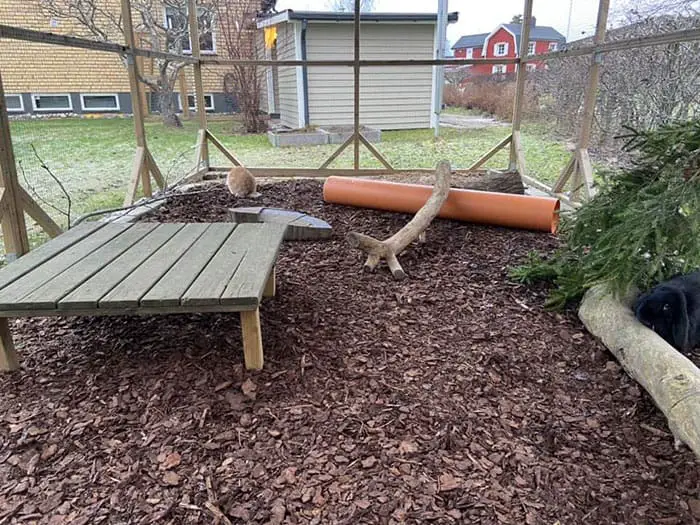
Instead of trying to keep the grass growing, Lisa chose low maintenance wood chips with natural logs for the bunnies to play on and around.
P.S. Did you find the bunny in this picture? He’s pretty hidden.
8. The Rabbit Rescue’s Rabbit Sheds
The last pictures of rabbit sheds I have to share all came from Lea. It’s my understanding that all of these bunny homes are at a single rabbit rescue in England.
While I don’t have multiple views of any of these rabbit sheds, I think the diversity of styles might provide some bunny friend with the inspiration they need to build the perfect bunny home in their backyard.
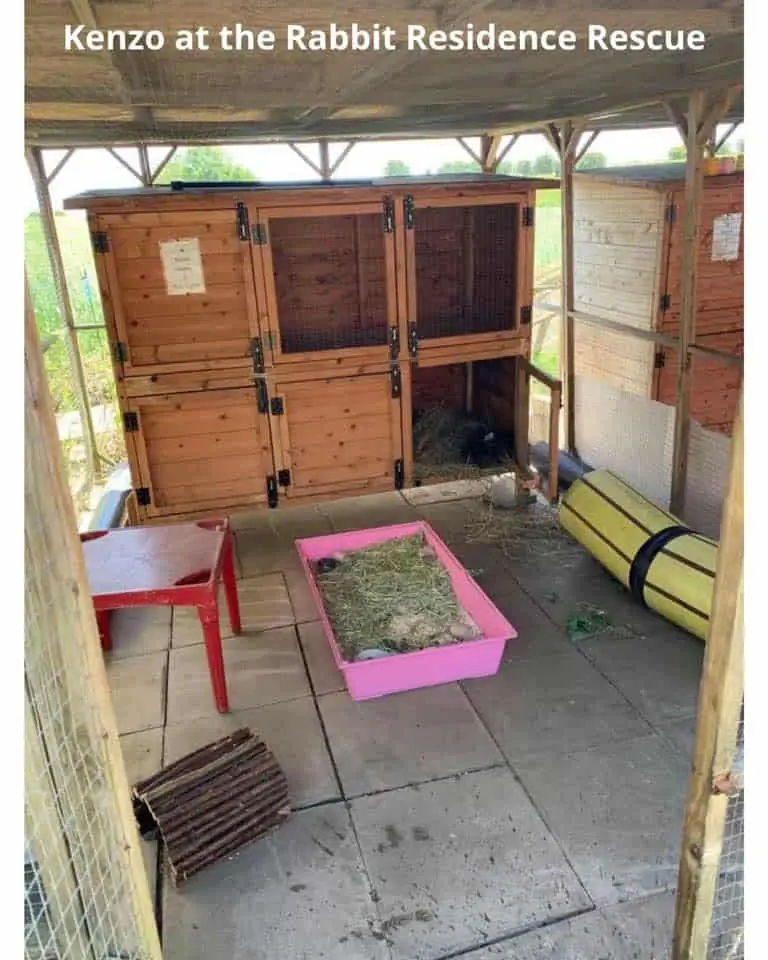
The shed in this one isn’t really a shed at all. Instead it’s very nice rabbit cages inside of an outdoor ‘room’ for the bunnies to play in.
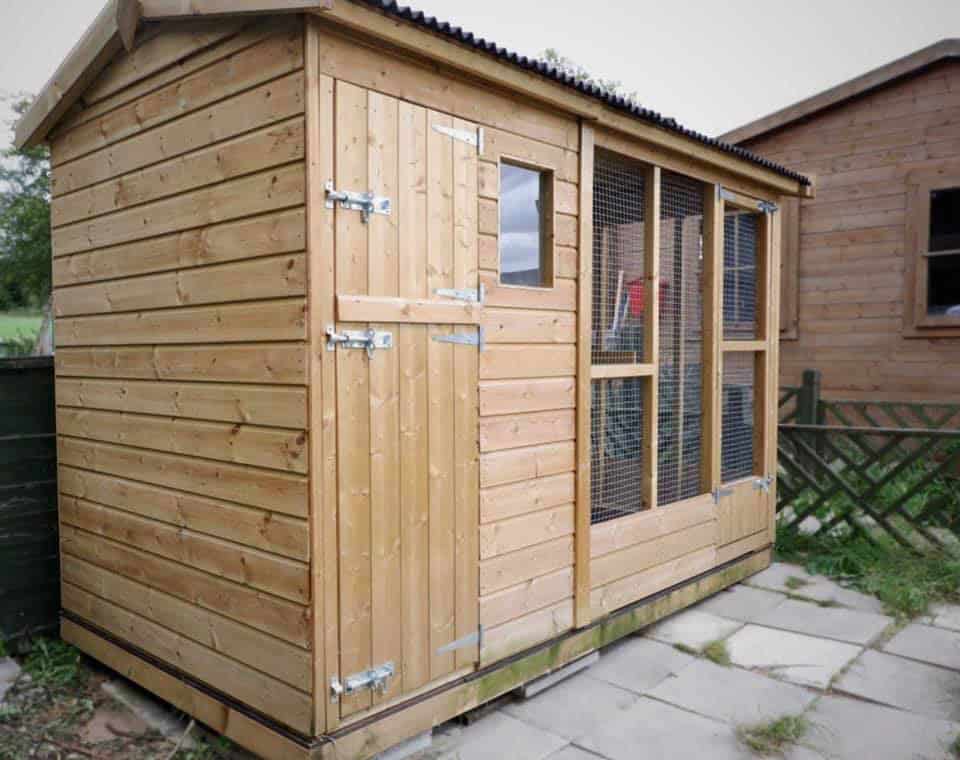
This rabbit shed has both the indoor living quarters and the play area within the shed.
If we do decide to offer prebuilt rabbit sheds, they are going to more like this one. Remember to signup for our email list and let us know in the comments that you might be interested in such a shed. We need to know there is demand before we proceed with such a costly project.

Another version of an all-in-one rabbit shed. This one looks like it has to separate homes…it’s a rabbit shed townhouse. LOL

A rabbit shed inside of the outside play area. Check out that hay manger…it’s adorable.
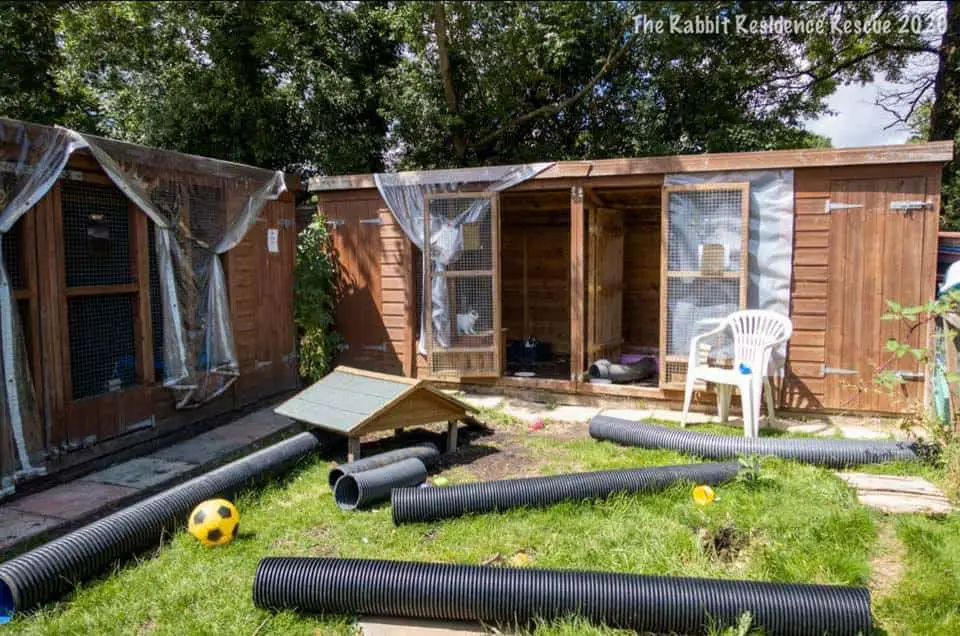
A couple more rabbit shed townhouses. These seem to have a central play yard. Looks like a nice place to live.
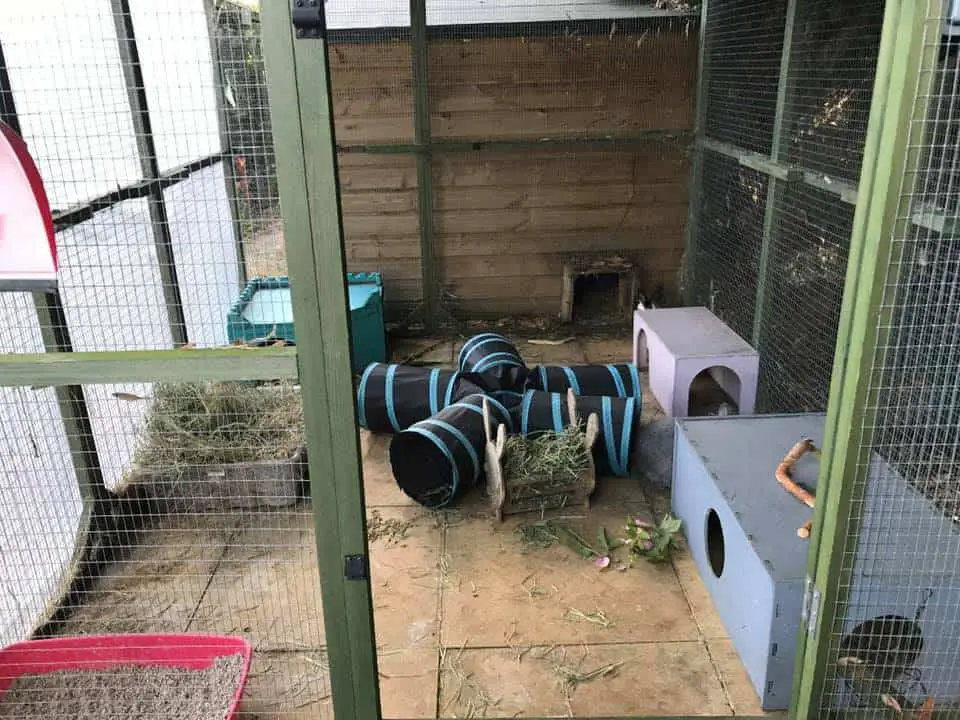
This rabbit run is attached to the rabbit shed on the side. That would make it super easy to get inside of the shed without being required to pass through the bunny run.
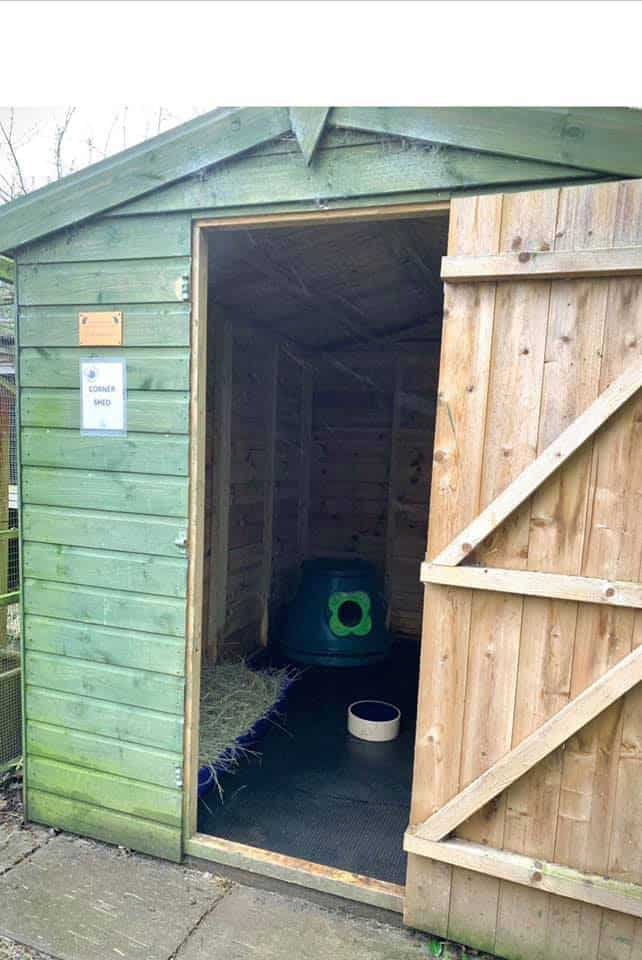
I’m assuming that this rabbit shed is attached to a rabbit run on a side we can’t see in this picture.
I think it’s a noteworthy picture to see how minimal a rabbit shed can be. There is a contained bed (the thing with the hole in the back) and a big little box full of hay. With the feed bowl and unseen water bowl, that’s all a bunny shed really must-have.

This is such a pretty little rabbit shed.
Once again, the shed part is more of a rabbit hutch, but that’s all you really need.

What a great play area!
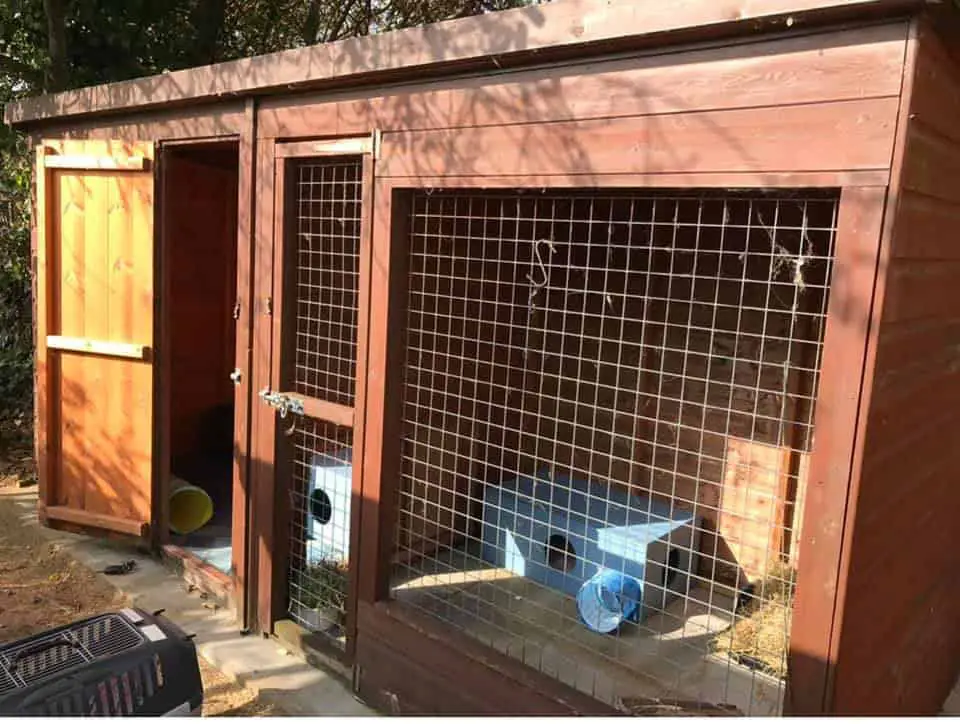
A better look at an all in one rabbit shed townhouse.
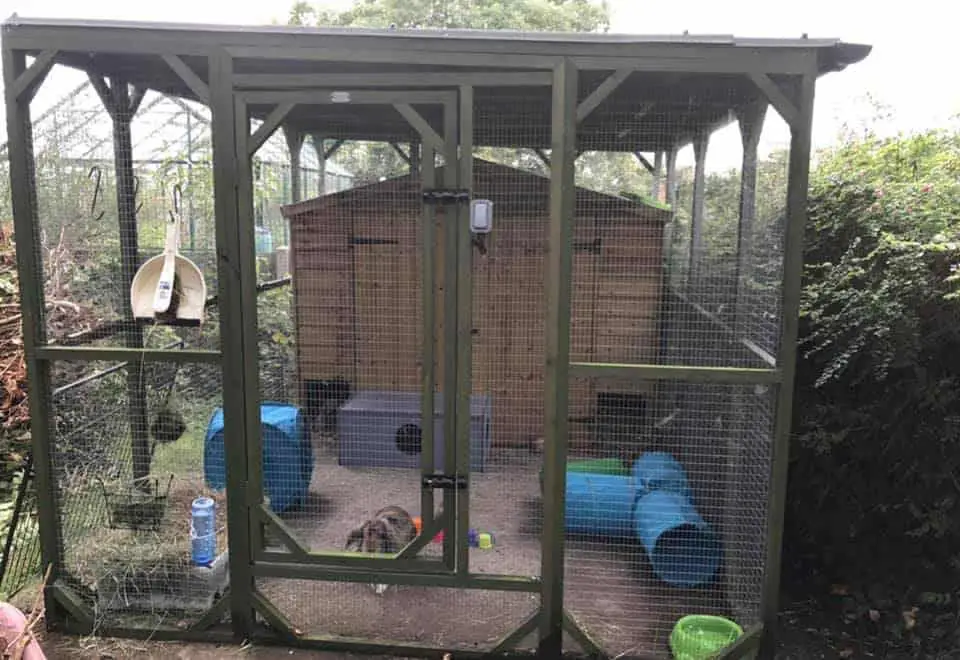
Another rabbit shed inside a rabbit run.
Cost To Build A Rabbit Shed
I know this question is rolling around it your head, but you also know it varies wildly.
A basic rabbit shed which includes an existing hutch inside a secure rabbit run will cost on average $300. A walk-in all-in-one rabbit shed that includes a rabbit run area will cost on average $750 if you build it from scratch. Converting a garden shed will cost about $300, assuming the garden shed was free.
Cost To Buy A Rabbit Shed
As I’ve mentioned before, we are considering building and selling complete rabbit sheds. While our design isn’t final yet, we do have estimates of the cost.
Buying a basic rabbit shed will cost you about $1,500. With customization to make it prettier or more comfortable for your bunny, a prebuilt rabbit shed will cost on average $2,500.
That’s all I got you about rabbit sheds today.
If you have a rabbit shed and would be willing to share pictures or even a video, please email me at [email protected] .
If you might be interested in purchasing a rabbit shed, email me too. We need to know there is demand before we proceed with this project.
Your Rabbit Friend,
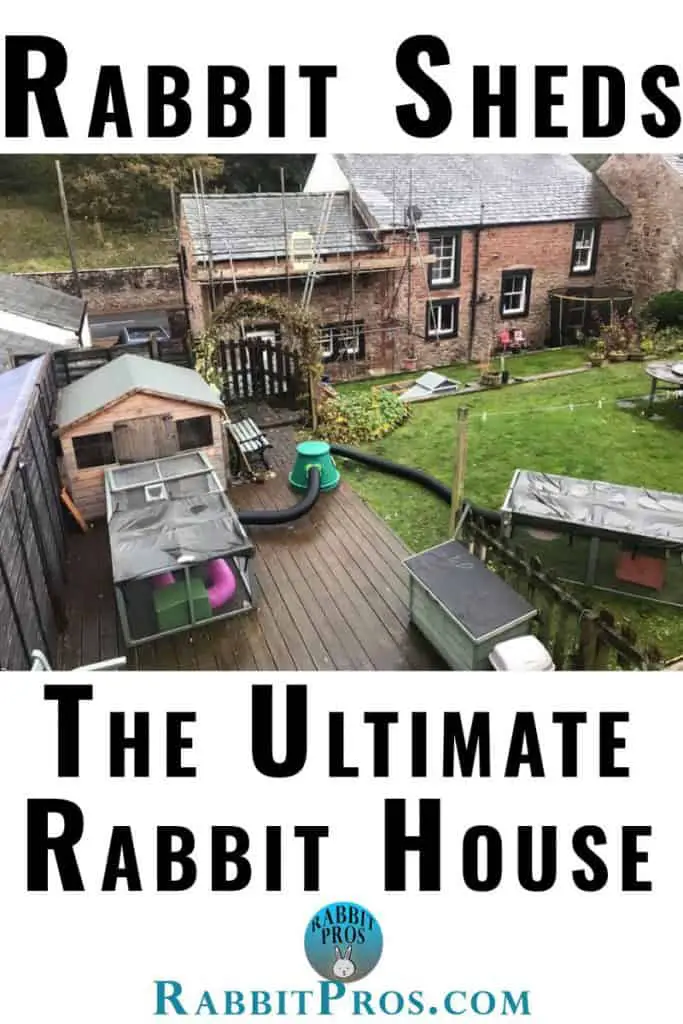
My name is Stacey Davis and my family has kept rabbits for decades. Here on RabbitPros.com we share our love of rabbits, our experience, and lots of research to help you enjoy your pet bunny even more.
One thought on “ Rabbit Sheds – The Ultimate Outdoor Bunny Hutch With Pictures ”
we are interested in buying a rabbit shed.
Leave a Reply Cancel reply
Your email address will not be published. Required fields are marked *
Save my name and email in this browser for the next time I comment.
Recent Articles
How Climate Change Effects Indoor Rabbits
While there may not be direct research specifically addressing how climate change impacts indoor pet rabbits, there are certain considerations and correlations we can discuss based on the general...
How to Take Your Rabbit to the Vet: A Step-by-Step Guide
Taking your pet rabbit to the veterinarian for the first time is a scary experience for both you and your bunny. Here are some tips to make the whole experience better for both of you! Choose...

Creating better tomorrows for all pet rabbits
Convert a garden shed, a hutch is not enough – so how about a shed.
Let’s just start with a reminder of our minimum size guidelines:
A single enclosed area of at least 3m x 2m by 1m high.
This is for 2 average sized rabbits, so if you have giant breeds you will need to increase that.
If the shed is smaller than 3m x 2m shed to convert then you will still need to attach a permanent exercise run to it.
Benefits of a garden shed:
More protection from the weather. For both rabbits and owners who are cleaning out and feeding
More space for the rabbits than a hutch, so they can rear up fully, stretch out fully, and jump etc.
Starting out
Firstly decide how much room you have for the shed and the run. Remember that the run does not need to be right next to the shed if you are going to use a Runaround system to connect them.
Once you have ordered your shed and built it we recommend you line it. This will offer insulation but also stop the rabbit chewing through the shed, or a determined predator chewing in.
In this work-in-progress example we have lined the shed with plywood, and made a shelf which is accessed by the rabbits via some decking steps made to size. This gives the rabbits more floor space inside and offers them a more enriched environment .
If you use thicker plywood to line the shed it offers more protection, and you can put insulation between the shed and the plywood.
It is a good idea to line the shed (and shelf) with lino to protect it from urine and whatever else the rabbits get up to. You can add vet bed, large litter trays on top of that. Don’t forget to add the pop holes, Runaround connectors or cat flaps so that your rabbits can access their safe exercise area.
Once you have finished it might look something like this. Note that this shed has two Runaround holes. This is so that the rabbits, who have prey animal instincts feel safe and always have the option of two escape routes from the shed or run area.

Don’t forget the ventilation!
It is a good idea to make a secondary mesh door behind the shed door which you can open during the day, especially in nice weather, to make sure that the rabbits do not get too hot. Drilling holes or removing a horizontal beam of wood from the walls just under the eaves of the roof will provide an air outlet. An air inlet is also required and should be created at about half the shed’s height, this prevents the rabbits sitting in a draught. This could be made by replacing the window with mesh or in a similar fashion to the air inlet.
This way natural ventilation is created drawing air into the shed, removing ammonia (from rabbit urine) and heat travelling up and out through the air outlet. This is the best way to reduce respiratory disease (snuffles, pneumonia) where the main contributor is from exposure to high ammonia levels burning the respiratory system, allowing bacteria to then invade the respiratory tissues. You will know you have got good ventilation when you don’t see cobwebs building up. Remember to cover all air vents with wire mesh to prevent predator entry.
An example provided by Wood Green The Animals Charity.
As the example shows, you are going to need a safe enclosed exercise area which is accessible to them 24/7. If you are going to build your own exercise area, remember that they need a roof and a floor too.
Note on this example how there is a kickboard at the bottom so that you can open the door and walk in without the rabbits rushing out! This is a great idea and something to incorporate if you can. It will also offer more safety as it will prevent anything that has chewed the bottom of the shed door getting in, or the rabbits chewing out.

Escape and intruder proofing
Regardless of whether you buy or build an exercise area, if it is sited on grass then sink the wire under the earth so that the rabbits can not escape and a predator can not dig in to get them.
You might prefer to site it on paving stones or decking, if you do this then it is a nice idea to give them a grazing tray. In fact have two, so that one can be in with the rabbits and one can be growing again.
The enclosure must be secure. If it’s outside then it has to keep out foxes, rats and other predators so the mesh and bolts must be of a good quality.
Go for welded mesh of a heavy gauge, not chicken wire, which they can bite through. Use a bolt you can padlock.
Give a lot of thought to the wire. There is a gauging system for thickness of wire and the lower the number, the thicker the wire. 16g (1.2mm) is the minimum we recommend. And 12g is even better. Ensure that the wire is properly fixed to the wood, attached on the inside.
The size of the holes in the wire is important. 13mm is perfect. This will keep out stoats, polecats and weasels, which are all a danger to rabbits but are smaller than foxes.
The staples that hold the wire to the wood must be as strong as possible so go for the sturdiest you can find.

This set up has everything in it that the rabbits would need. The shed is converted . There are 2 bolts on the door, top and bottom for extra security. We have used 12g 13mm wire attached by strong galvanised wire staples. There is a felt roof for protection and there is wire sunk under the grass area. There are 2 holes for entrance / exit between the shed and the exercise area.
Inside the run you will see we have given the rabbits:
- Platforms to sit on and look for danger.
- This also allows them to stretch and jump
- Grass to graze and hay available at all times
- Hiding places
- A place to dig
- Space to sit apart from each other if they want to
- Plenty of space to run, jump and binky.

Donate | Join
Rabbit Welfare Association & Fund
61 Bridge Street, Kington. HR5 3DJ
© 2022 Rabbit Welfare Association & Fund (RWAF)
The Rabbit Welfare Fund or RWF is a registered charity #116709
Privacy Policy
Cookie policy, policy statements.

Site by &Something
About us | Contact Us | Sitemap | Press Centre
Privacy Policy | Cookie Policy | Policy Statements
The Rabbit Welfare Fund or RWF is a registered charity #1167093
About us | Contact Us
Sitemap | press centre, privacy policy | cookie policy |.

This website uses cookies to ensure you get the best experience
How to Convert Your Garden Shed into a Rabbit House
October 21, 2022
Last modified: June 19, 2024
gardenbuildingsdirect

Image Credit: Nennieinszweidrei / Pixabay
Rabbits can be misunderstood pets, with different “experts” sharing differing advice. When it comes to their habitat, many pet shops sell small and unsuitable cages, leading to rabbits being chucked outside, and confined to a tiny crate. According to the Rabbit Welfare Association & Fund (RWAF) a hutch alone is not enough.
Rabbits require a large amount of space, a minimum of 3m x 2m x 1m for 2 average-sized rabbits. If your shed is smaller than 3m x 2m your rabbits will also require the addition of a permanent exercise run. Therefore, if you’re thinking about buying a rabbit, RWAF recommends converting a shed or playhouse into a dream house for your furry friends.
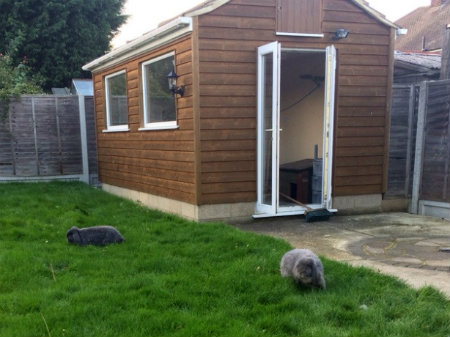
Benefits of using a garden shed for a rabbit house
There are many benefits to using a garden shed to convert into a bunny house, these include:
- Your bunnies can live a happy life with plenty of space to run, jump and enjoy
- It gives your old garden shed or playhouse a purpose again
- Easier to clean out in the winter than a standalone hutch
- It’s easy to do and can last a lifetime for a bunny
Types of Shed to use
As with any shed conversion, there will be a lot of work upfront, however, once the conversion is done, you will have peace of mind knowing your rabbits can live happily in a space where they feel comfortable.
However, whether you are buying a new shed or converting an old one, there are requirements you need to follow.
Materials to use (and not to use)
- Do not use a metal shed as these can get hot in the summer and overheat easily, as well as the lack of ventilation in them.
- Avoid plastic playhouses as they will not be secure enough from other animals or protect against different weather conditions
- A wooden shed makes for a perfect rabbit home; however, some changes need to be made before putting your rabbits in the shed. This includes reinforcing the boards in the shed to stop bunnies from getting out and other animals from getting in.
Where to Start?
First things first you need to decide which shed you are going to use, whether you’re looking to purchase a new one from Garden Buildings Direct or refurb one you already have, the process is similar. However, if you are using an old shed, you will need to make sure it is still in good shape. If you are using a new shed, you can get straight on to the conversion.
If you are looking to purchase a shed for the project, the bigger the better. Some great choices for this are:
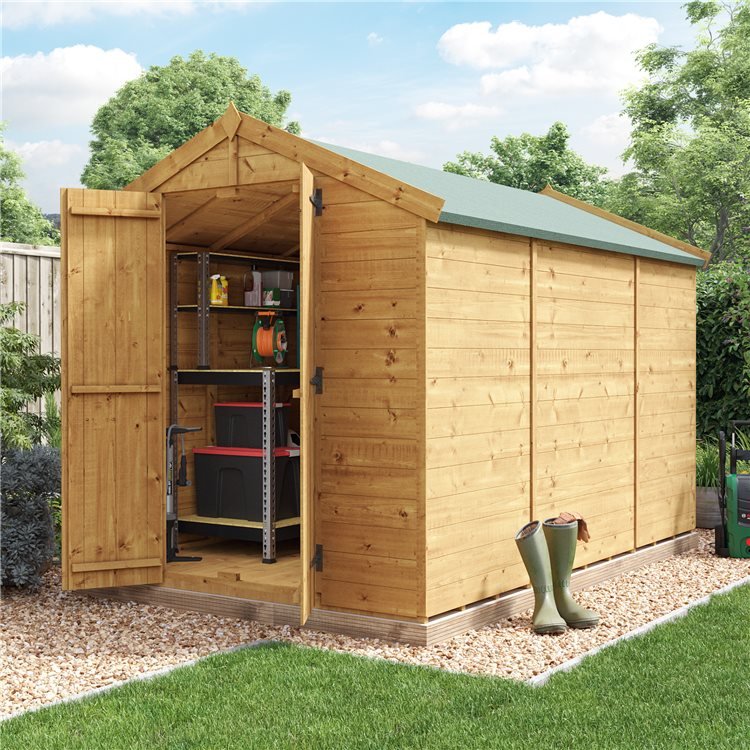
1. BillyOh Keeper Overlap Apex Shed
The BillyOh Keeper shed is an ideal shed for this project, as it comes in a variety of sizes. Depending on space and budget, buying one of the larger Apex sheds provides your rabbits with extra room to roam free and express themselves.
This shed comes can have added windows which is crucial for a rabbit. As stated by Rabbit Care Box ‘ Rabbits do not have any tool to understand the time of the year. They use natural light to know the time’ without this they may feel lost.
2. BillyOh Expert Tongue and Groove corner shed
If you have a smaller garden this corner shed may be great as it slots into the corner but does not compromise on space. Although these sheds are nice looking on the outside, they will require extra customisation for the shed to make sure that it fits their needs. f
3. Master Tongue and Groove shed
If space isn’t an issue in your garden, you may want to consider the Master shed, with the size of this shed going up to 12×8, your rabbits can have the ultimate living quarters. Although this shed comes in large sizes, you can also opt for a smaller size of this classic-looking shed.
Alternatively , if you are looking to convert a playhouse, here are some suitable options-
4. Gingerbread Junior Playhouse
A great pick if you are choosing to convert a playhouse, one of the best features of a playhouse over a shed is the door. Most playhouses have a door which splits in two, allowing you to feed your rabbits without them escaping via the bottom door.
This playhouse is a decent size, with windows, however, you will need to cover these with a protective covering as these are open.
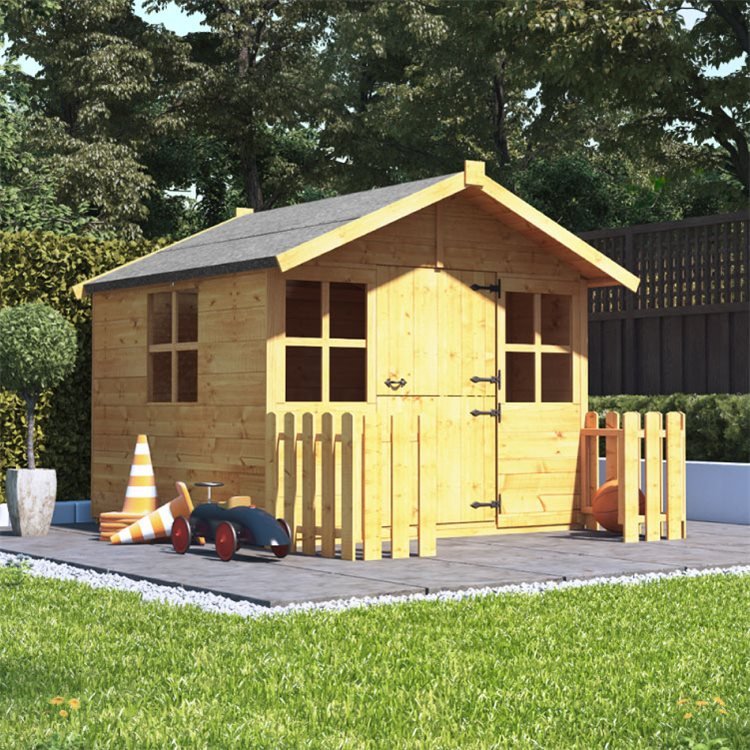
5. Lollipop Junior Playhouse
The Lollipop junior playhouse offers a lot of similar qualities and features to the gingerbread one, however, this one has styrene windows, which are shatterproof. This is great as it provides an extra element of warmth in the colder months.
When you’ve decided on your shed, it’s time to decide the location, it’s important to consider what your shed will be on. A great suggestion is paving slabs or a deck.
Now you’ve decided on the shed you are going to use and the location of the shed, it is important to start renovating it to make sure it is secure, easy to clean and safe for your rabbits to live in.
What you need in your Rabbit Shed
Before your bunnies move into their new home, it is important to do some modifications in order to make the shed a safe place for your rabbits to live.
Although your shed will have wooden flooring, rabbits can often make a mess on the floor, which can eventually lead to the wood rotting. Putting lino down on top of the wood not only makes it easier for you to clean them out but also will preserve the wood, you can grab a roll of lino for a lot cheaper than replacing the whole shed floor!
Hutch or Hideout
Even though the rabbits have the shed to themselves, they enjoy going into places where they’re hidden as they feel safer there. As well as, having a hutch provides extra warmth when it is cold, as rabbits love to snuggle somewhere cosy.
Ventilation Holes
Even during the winter, ventilation holes are an important part of a converted shed. Pets4Homes advise that drilling up high on the walls creates good airflow.
Insulate Shed Walls
As a rabbit owner, you likely know that rabbits love nothing more than to chew on wood, therefore making sure you insulate the walls on the inside to protect them from being nibbled is super important.
You can use wallpaper, which is used in bathrooms as a solution, or alternatively double panel the walls, that way if the inside gets chewed, there’s an extra layer which can easily be replaced.
You may want to consider a litter tray or two in their shed as rabbit owners know too well how often rabbits use the toilet, a litter tray makes it a lot easier to clean them out.
Escape and Intruder Proofing
Unfortunately, animals such as foxes and rats are rife around outdoor rabbits, so making sure these animals can’t find a way inside the converted shed or exercise area is so important for their safety.
Attaching a Run
This is optional if your shed is bigger than 3m x 2m, however, if it is a smaller space than this, it is required. Rabbits require this space to be happy and healthy. They need to be able to run around and express themselves.
It is important to note you will need to take extra measures to protect the run from unwanted visitors, and to stop your rabbits from digging their way out.
If your shed is on grass, like putting the shed on a raised platform, raising the run is one of the best ways to protect your buns. If it is on a concrete base, there is no way of your rabbits digging under it to get out.
However, if your shed is already on paving this is likely to be secure enough to stop anyone digging underneath.
Don’t use Chicken Wire
Sadly, this mistake is often used when creating a run for rabbits and can have devastating consequences. Chicken wire is known for being flimsy and easy to bite through. Find an alternative such as a welded mesh of a heavy gauge, the thicker the better.
Wire Sizing
Although you may be able to keep foxes out with mesh, it is important to consider the size of the holes in the wire throughout any part of your enclosure, as other animals are dangerous to rabbits, which are considerably smaller than foxes.
The minimum thickness for the wire is 1.2mm, however, aiming for thicker is better as it’s more secure. Regarding the sizing in the holes, 13mm is the perfect size to stop smaller animals such as stoats, weasels, and polecats from getting into the enclosure.
Attach thick Wire to the Wood
When attaching the wire to the wood it is essential to make sure this is secure and that there are no gaps. Using heavy-duty staples to attach the wire to the wood is one of the best ways to make sure it is secure.
Provide a way for your Bunnies to access the Run
Ideally, your rabbits will have 24/7 access to their run, so making sure the run is easily accessible to your bunnies is important. However, on a converted shed, you need to consider how to make a safe way for them to get into the run.
Owners have been known to get a cat flap fitted, to allow their buns to get out easily. One of the perks of getting a cat flap is you can lock it shut if you ever need to, during times of bad weather such as storms.
Whether you’re a new bunny owner or looking to become one, it is important to create a space where they feel safe and happy. Therefore, converting a shed or outdoor playhouse is the ideal solution.
If you have indoor rabbits and you are looking to convert them to being outside in a shed conversion it is important to do it gradually as the change in temperature can be dangerous.
If you have converted your shed or playhouse, we’d love to see your creations!

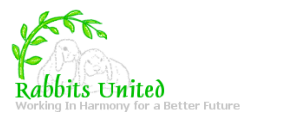
- Search forums
Follow along with the video below to see how to install our site as a web app on your home screen.
Note: This feature currently requires accessing the site using the built-in Safari browser.
- Forum/Server Upgrade If you are reading this you have made it to the upgraded forum. Posts made on the old forum after 26th October 2023 have not been transfered. Everything else should be here. If you find any issues please let us know.
- Rabbit Care Help & Advice
My Rabbit Shed Tour
- Thread starter Mischief and Tinker's Mum
- Start date Feb 18, 2014
Mischief and Tinker's Mum
Wise old thumper.
- Feb 18, 2014
Brilliant shed! Arent your bunnies clean! If that was my lot there would be poop everywhere :lol:
Warren Scout
Rabcat said: Brilliant shed! Arent your bunnies clean! If that was my lot there would be poop everywhere :lol: Click to expand...
RafaelIsCoolButRude
Captain Helen
- Feb 19, 2014
- Feb 21, 2014
This looks wonderful! Definitely taking down some tips for when we get our shed!!!
- Feb 22, 2014
JessieandFaith
Similar threads.
- Mar 18, 2024
- Apr 13, 2024
- CookieDough4Ever
- Mar 19, 2024
Converting a shed for rabbits
Thinking of making better use of your shed? Why not convert it into a house for your rabbits! Wooden garden sheds or Wendy houses make an ideal home for small pets such as rabbits.

Sam - Small animals behaviour and training specialist
Converting sheds or Wendy houses are a great way of providing a large sheltered enclosure for small pets like rabbits to use. They might be well suited to families who want to socialise with their small pets in comfort while being protected from wet or cold weather. If this is something you’re considering, you must first ensure they are suitable to be used for housing. They will need some improvements to make sure there’s sufficient ventilation, while keeping your rabbits safe and secure from any potential predators.
Before you start your project of converting a shed for rabbits, make sure it’s structurally sound, with no gaps, holes or rotting wood. The shed or Wendy house will also need to be placed on a hard-standing surface. Alternatively, you’ll need to install a solid floor to prevent your rabbits from digging and chewing. It will also provide a secure base so that predators like foxes can’t find their way in by digging.
Installing locks
Another upgrade to consider when converting a shed for rabbits is suitable locks. Installing locks will further ensure your rabbits stay safe and secure. Here are a few recommendations:
- Use sliding bolts on the outside of the door to keep it in place and secure.
- Place two bolts on the outside – one at the top and one at that bottom. This will ensure that there is no danger of any animals being able to push out and escape.
- Swivel latches should not be used as children and also predators can easily open these.

Sliding bolt & padlock on shed door

Providing fresh air
If you’re thinking about converting your shed for your rabbits’ accommodation, make sure it’s well ventilated to ensure a good flow of air throughout the year. This will help to prevent respiratory illnesses. Wooden sheds and wendy houses get very hot in the summer months, so having good ventilation can help in circulating this air.

Window ventilation on a shed
Here are some things you can do:
- Windows – replace any windows with small gauge welded mesh, attaching it to the inside of the window frame. Chicken wire is not suitable – predators can easily get through it and rabbits can chew through it.
- Inner mesh door – Create a wooden framed inner mesh door, using small gauge welded mesh. This allows you to leave the main shed or Wendy house door open throughout the day during the summer, without risk of your pets getting out or predators getting in.
- Or, create a stable door with an inner mesh door – Cut your main outside shed or Wendy house door along the middle to create a stable type door. This will allow you to keep the bottom section closed, whilst creating a wooden framed inner mesh door for the top half. You can then leave the top half of the main shed door open throughout the day without risk of your pets getting out or predators getting in.

Rabbit wendy house inner door
Adding insulation
To help keep your rabbits cosy in the winter months, it’s worth lining the walls of your shed or Wendy house with large sheets of wood or plywood with insulation in between. This will also prevent your pet rabbits from chewing the walls.
Stopping escapees!
Inevitably, pet rabbits will want to hop over to greet us at the door, and this can be tricky especially if you want to go in without them escaping. A simple and easy solution is to create a step over barrier. Secure this on the inside of the shed and their run across the bottom of the door frame – it will allow you enough time to get in and shut the door behind you to help prevent your rabbits from getting out.
It is always a good idea to line the floor of the shed or Wendy house with something like lino – this will make it much easier to clean and prevent the floor from become urine stained and rotting.
Connecting a run and large enclosure
Connecting your shed or wendy house to a secure run is a great way of allowing your rabbits to safely and happily access two areas.

Tunnel connecting wendy house and run
There are a number of ways you can do this:
- Connect them using a tubing or tunnel system. Visit RunAround for inspiration.
- Attach the run directly onto the shed or Wendy house using suitable wood screws and create a hole between the shed and run. Make sure this is big enough for your pet rabbits to easily walk through.
- Place the shed or Wendy house within a secure aviary, creating a hole in the shed large enough for your rabbits to easily walk through.
Read our article on how to house your rabbits and find out the ideal sized run or aviary for your pets.
Rabbit e-learning course
A brand new e-learning course taking a look at what makes rabbits healthy and happy.
Learn more about accommodation, diet, companionship, vet care, handling and find out what a binky is! Free!
How helpful was this?
Thanks for your rating
Rated this article 3 stars or less? Tell us what we could do to make it more helpful.
Related content

Building a better home for rabbits

Being there for bunnies: Ronnie and Roxie’s story
When the owner of two ‘female’ rabbits – Ronnie and Roxie – discovered a litter of four babies, it came as quite a shock!

Rehoming FAQs
Got a question about rehoming a pet from Woodgreen? You may find the answer you’re looking for below.
© 2024 Woodgreen Pets Charity. Woodgreen is a registered charity (no. 298348) and a company limited by guarantee (no. 02073930). Registered office Kings Bush Farm, London Road, Godmanchester, PE29 2NH.

Our Lovely Rabbits is supported by its audience. When you purchase through links on our site, we may earn an affiliate commission.

Do Rabbits Shed?
Many rabbit owners might wonder if their furry friends shed, especially when they start to notice tufts of fur scattered around their living spaces. Rabbits do, in fact, shed their fur periodically. This natural process, called molting, occurs in all rabbits and helps them maintain a healthy coat appropriate for the changing seasons. Understanding the shedding process and its underlying causes is vital for ensuring proper care of rabbits and keeping their environment tidy.
- Video – Do Rabbits Shed?
Watch this informative video to find out more about why and when rabbits shed.
There are several factors that influence the shedding process, such as the breed and age of the rabbit, as well as environmental and seasonal changes. It is important for rabbit owners to be aware of their pet’s shedding patterns and take appropriate measures to manage the shedding process, minimize the mess it may cause, and maintain the overall health and well-being of their rabbit.
Table of contents
Key takeaways, why do rabbits shed, the shedding process, role of breed and age in shedding, seasonal factors influencing shedding, importance of diet, issues in excessive shedding, grooming and care, health conditions related to shedding, the role of environmental changes, how to contain shedding, do rabbits shed during winter, what causes rabbits to shed in clumps, is shedding common for rabbits in summer, what kind of brush should be used for rabbit shedding, how does indoor living impact rabbit shedding, how does rabbit shedding compare to cat shedding.
- Rabbits do shed their fur through a process called molting, which helps maintain a healthy coat appropriate for the changing seasons
- Factors such as breed, age, seasonal changes, and diet can influence the shedding process
- Proper grooming, care, and attention to environmental factors can help manage and contain rabbit shedding.
Rabbits shed their fur as a natural process for various reasons, primarily for temperature regulation and adaptation to seasonal changes. They typically experience molting, which occurs roughly every three months, resulting in shedding of their coat to have a fresh layer of fur.
During spring and autumn, rabbits undergo significant shedding as they prepare for the upcoming seasons. In spring, they will shed their thick winter fur to grow a lighter coat for the hot summer months. Similarly, in autumn, rabbits will shed their lighter summer coat and grow a thicker, denser undercoat to keep them warm during winter. The undercoat, made of dense, soft fur, provides insulation and helps regulate the rabbit’s body temperature.
Aside from temperature regulation and seasonal changes, other factors may also contribute to rabbit shedding. Stress, boredom, and ill health are possible reasons for abnormal changes in a rabbit’s coat, causing bald patches to appear. It’s crucial to observe your rabbit’s shedding patterns and ensure that it maintains a healthy fur coat throughout the year.
To keep your rabbit comfortable and well-groomed during shedding seasons, it is essential to follow proper grooming practices. Regular grooming not only prevents matting and choking hazards from ingesting loose fur, but it also helps to keep the bunny’s environment clean and lowers the risk of health issues influenced by stress or poor coat maintenance. A well-groomed rabbit is a happy and healthy rabbit, with their shed fur naturally fulfilling its intended purpose in adapting to various conditions.
While shedding is a normal process for rabbits, it’s essential to keep an eye on rabbit weight since excessive shedding might cause unusual fluctuations in their weight, and to be aware of rabbit sleeping habits during shedding seasons, as disturbances to their rest could contribute to increased stress levels. Additionally, rabbits, like any creatures, have unique mating patterns that also influence their overall health and well-being.
Rabbits shed their fur as a part of their natural molting process, which helps maintain the health and temperature regulation of their coat. This physiological mechanism can be an outward sign of normal hormonal changes in the body or triggered as a response to the external environment. Ideally, rabbits will shed twice a year, following a predictable pattern.
The shedding process in rabbits is essential for growing a new coat of fur. As seasons change, so does the rabbit’s need for different types of coats. During the winter months, rabbits require a thicker coat to stay warm, while in summer, they lose this fur and grow a lighter one to adapt to the warmer weather. The molting pattern can last for roughly ten days before new fur begins to grow.
All rabbits will shed their fur to some extent throughout their lives, though the frequency and amount of shedding may vary depending on their breed and grooming habits. Rabbits with long hair may need to groom themselves more frequently, licking off the excess fur to maintain their coat’s health.
It is important to monitor your rabbit’s shedding patterns and check for any irregularities. While shedding is a natural and healthy process, excessive or sporadic shedding might indicate an underlying issue.
In summary, rabbit shedding is a normal part of their life cycle that helps maintain their fur’s health and adapt to different environmental conditions. Shedding patterns are generally predictable, and observing these patterns in your rabbit is essential to ensure their overall well-being.
Different rabbit breeds shed their fur at varying rates, and a rabbit’s age can also influence shedding patterns. For instance, Angora rabbits are known for their long and thick fur, which requires frequent grooming to prevent matting and other issues. In contrast, breeds like the American Rabbit or American Chinchilla Rabbit might shed less, making them easier to care for.
Young rabbits may shed less than adult rabbits because they are still growing into their full-sized coats. As rabbits reach adulthood, shedding may become more noticeable and consistent. Typically, rabbits molt two to four times a year, with the most significant shedding occurring during seasonal changes in spring and autumn.
Long-haired rabbits, such as Angora and Astrex rabbits , tend to have more complex shedding patterns due to the extended length and volume of their fur. This requires rabbit owners to invest more time and effort in grooming and maintenance. Regular grooming is crucial to reduce the risk of health complications arising from ingested fur or matted coats.
On the other hand, short-haired breeds like the Mini Rex Rabbit and the American Sable Rabbit generally shed less and have simpler shedding patterns. As a result, these breeds tend to be lower maintenance and easier to care for compared to their long-haired counterparts.
In conclusion, various factors such as breed, age, and fur type play a role in shedding patterns among rabbits. Understanding these factors can help rabbit owners adjust their grooming routines and properly care for their pets.
Rabbits, like many animals, shed their fur in response to seasonal changes in temperature and daylight. As the days become longer in the spring, rabbits begin shedding their winter coat to prepare for the warmer season ahead. On the other hand, during the fall, rabbits will start shedding their thin summer coat in favor of growing a thicker layer of fur for the upcoming winter months.
Weather fluctuations and climate also play a role in their shedding patterns. In regions with more radical changes in temperature, rabbits may experience more defined shedding seasons as they adapt to the shift in weather. Temperature regulation is crucial for rabbits to maintain good health and comfort levels, so shedding becomes an essential aspect of their biology.
During the shedding season, you might notice that rabbits shed a lot, which is their natural way to adapt to the climate variations. The shedding process allows them to insulate their bodies and regulate their temperature by having a thick fur coat for keeping warm in the winter and a thinner coat for the summer.
It is essential to be aware of certain factors that can influence and complicate rabbit shedding. Rabbits experiencing stress, boredom, or ill health may exhibit bald patches or unusually heavy shedding. Always ensure that their living environment is suitable and well-maintained to avoid such issues.
In the wild, this shedding process may attract predators such as foxes , skunks , and even groundhogs due to the natural instinct to prey on vulnerable animals. Meanwhile, crows may prey on young rabbits that have not yet developed a fully protective coat.
In conclusion, the shedding process in rabbits is primarily driven by seasonal factors, including changes in daylight and temperature. Ensuring a suitable environment and attending to their grooming needs will help rabbits maintain a healthy and comfortable coat throughout the shedding seasons.
Providing a balanced diet for rabbits is crucial in maintaining their overall health and well-being. A rabbit’s diet should primarily consist of high-quality hay, which offers essential fiber for proper digestion and dental health. Timothy hay is often the preferred choice for rabbit owners due to its balanced nutrition and rough texture that helps wear down rabbit’s teeth. Can rabbits eat maple leaves? provides more information on feeding rabbits with other types of leaves as well.
In addition to hay, fresh grass can also improve the rabbit’s diet, offering more opportunities for the animal to browse and promoting natural foraging behaviors. Including a variety of vegetables in their diet contributes important vitamins and minerals that rabbits need. It’s essential to research which fruits and vegetables are suitable for rabbits, as some can be harmful to their health. For instance, Can Rabbits Eat Cherries? and Can Rabbits Eat Avocado? inform rabbit owners about the safety of these specific foods.
A rabbit’s diet also requires an adequate amount of protein and other nutrients, which can be supplied through high-quality pellets. Offering limited amounts of pellets can ensure that rabbits maintain a balanced diet and avoid relying solely on pellets as their food source.
Proper nutrition plays a significant role in rabbit shedding patterns, as a well-nourished rabbit will likely have a healthier coat. Grooming techniques and diet considerations can help rabbits through their natural shedding process. Keeping them hydrated is also important, so make sure to provide fresh water daily.
In conclusion, providing a balanced diet for rabbits is essential in maintaining their health, dental care, and proper shedding patterns. Including high-quality hay, fresh grass, vegetables, and limited amounts of pellets can ensure that rabbits receive the necessary nutrients in their diet. Regularly researching and learning about rabbit-safe foods, like Can Rabbits Eat Olives? , can also help rabbit owners make informed decisions about their pet’s diet.
Rabbits naturally shed their fur, a process known as molting, which occurs regularly to help maintain a healthy coat. However, excessive shedding can sometimes signify a potential health issue or stress factor in your rabbit. It is essential for rabbit owners to understand the causes of excessive shedding and how to differentiate it from regular molting.
One common cause of excessive shedding in rabbits is stress. Factors such as changes in environment, noise, or living conditions can cause rabbits to shed fur in patches. In some cases, this can lead to bald spots or alopecia, which is a more severe issue. To address this issue, try to minimize stress factors in your rabbit’s environment and monitor its overall well-being.
In addition to stress, health concerns like dental problems, parasites, mites, and infections can lead to excessive shedding and bald spots. It is crucial to treat these underlying issues to ensure your rabbit maintains good health and prevent the death of your bunny. Regular veterinary checkups and monitoring your rabbit’s overall health can help detect and address these problems early on.
A rabbit’s external environment also plays a significant role in excessive shedding. Seasonal changes, specifically in spring and autumn, can cause rabbits to go through heavier shedding periods. During these times, their fur coats may shed more rapidly than usual, taking just days or weeks to complete the molting process. It’s important to note that this is a normal part of a rabbit’s life cycle and does not necessarily indicate a problem.
Lastly, lack of proper grooming can lead to excessive shedding in rabbits. Regularly grooming your rabbit using a proper tool, such as a slicker brush or a comb, can help prevent this issue. By doing so, you are ensuring the healthy removal of dead hair from your rabbit’s coat and promoting proper circulation to the skin.
In conclusion, it’s essential to carefully observe your rabbit’s shedding patterns and be aware of the possible causes and treatments for excessive shedding. By doing so, you can ensure your rabbit’s health and well-being, addressing any issues before they escalate into more significant problems.
Rabbits have delicate skin and fur, and they require proper care and grooming to maintain their good health. Grooming involves brushing, combing, and attending to your rabbit’s fur coat.
Brushing is an essential part of rabbit grooming and should be done at least once a week. This helps prevent the formation of hairballs, which can cause digestive issues in rabbits. Regular brushing also allows you to observe any skin problems or parasite infestations early on.
When combing , use a fine-toothed comb to gently remove loose hairs and tangles from your rabbit’s fur. It’s important to be gentle during this process, as rabbits have fragile skin that can easily be injured if combed too aggressively. Comb your rabbit’s fur in the direction of hair growth to minimize discomfort.
Rabbits undergo seasonal shedding, which means they grow a thicker fur coat in winter and shed it for a thinner one in summer. During shedding season, rabbits may require more frequent grooming—up to several times a week—to help keep their fur healthy and prevent excessive loose hair buildup.
When grooming your rabbit, be mindful of their delicate spine and provide support to prevent injury. Pay close attention to areas that are difficult for your rabbit to reach, such as the underside and around the hindquarters.
In addition to brushing and combing, regularly check your rabbit’s nails and trim them as needed. This helps prevent overgrown nails that can cause discomfort and difficulty in walking.
By maintaining a proper grooming routine, you can help keep your rabbit’s fur coat healthy, comfortable, and free from tangles and shedding-related issues. With your confident, knowledgeable approach, your rabbit will benefit from a well-groomed and cared-for coat.
Rabbits are known to shed their fur seasonally, but excessive shedding can sometimes be indicative of underlying health issues. Several factors such as skin conditions, parasites, and even dental issues can contribute to excessive shedding in rabbits.
One common problem that leads to fur loss is the presence of parasites like fur mites, fleas, and even ringworm. Fur mites often cause itching, irritation, and dandruff, and if left untreated, can result in patches of bare skin. Fleas can be equally dangerous, causing severe itching and even anemia in extreme cases. Ringworm, a type of fungal infection, can result in circular patches of fur loss.
Hairballs can also cause a rabbit to shed excessively. Rabbits groom themselves frequently and can ingest hairs in the process. While they cannot vomit to expel hairballs like cats, they usually pass them through their digestive system. However, if a hairball becomes lodged, it can lead to life-threatening gastrointestinal obstruction. Regular grooming and providing a fiber-rich diet can help prevent hairball-related issues.
Another possible factor in excessive shedding is urine burn. Rabbits with poor bathroom habits or limited access to clean environment may end up with urine-soaked fur, leading to skin irritation and fur loss. Urine burn can be prevented by maintaining a clean living environment and providing proper litter training to your rabbit.
Some rabbits can experience dental issues, which can lead to excessive shedding. Overgrown teeth or other dental problems can make grooming difficult and uncomfortable for your rabbit, causing them to neglect their coat. Regular dental check-ups with a vet can help keep your rabbit’s teeth in good condition and prevent shedding due to dental issues.
Lastly, underlying skin conditions such as bacterial or fungal infections, allergies, or dry skin can lead to excessive shedding. It is essential to consult with a veterinarian to identify and treat any potential skin disorders that may contribute to fur loss.
If you suspect your rabbit may be shedding excessively due to a health condition, it’s important to consult with a vet for proper diagnosis and treatment. Regular grooming and monitoring of your rabbit’s overall health can help prevent fur-related problems and ensure a healthy, happy pet.
Environmental changes play a significant role in the shedding patterns of rabbits. Rabbits are sensitive creatures that respond to fluctuations in temperature, humidity, and light. As such, their shedding habits change throughout the year to accommodate these external factors.
Temperature is a key factor that affects shedding in rabbits. During warmer months, rabbits shed more to remove excess fur and maintain their body temperature. When the temperature drops in colder seasons, rabbits grow a thicker coat to keep them warm. Indoor rabbits living in controlled environments may not experience drastic temperature changes, but they may still shed as their body responds to subtle changes in their surroundings.
In addition to temperature, the amount of light available also impacts rabbit shedding. As the amount of daylight changes throughout the year, rabbits adjust their shedding patterns to match the seasonal shift. For instance, rabbits typically shed more during the transitional periods of spring and fall. Indoor rabbits may have less exposure to natural sunlight, which can alter their shedding patterns. To ensure a healthy shedding process for indoor rabbits, it is essential to provide consistent lighting schedules and mimic natural light changes as much as possible.
Humidity plays a role in rabbit fur maintenance as well. High humidity levels can lead to excessive shedding, while low humidity can make their coat dry and prone to breakage. To help maintain optimal fur health for indoor rabbits, it is essential to maintain stable humidity levels in their living space.
Rabbits may also shed more when under stress due to changes in their routine, diet, or environment. By providing a secure and comfortable environment for your rabbit, you can support a healthier shedding process and reduce the likelihood of stress-induced shedding.
In summary, the role of environmental changes in a rabbit’s shedding pattern is significant, encompassing factors such as temperature, light, and humidity. Understanding how these factors relate to shedding can help rabbit owners better care for their pets, both outdoors and indoors. Keeping a keen eye on environmental conditions and making necessary adjustments will contribute to the overall health and well-being of rabbits.
Rabbits, like many other furry pets, shed their coats throughout the year to adjust to varying temperatures. Keeping a pet rabbit’s shedding under control is important for their health and the cleanliness of their environment. This section provides tips on how to manage and contain your rabbit’s shedding effectively.
One of the best ways to manage shedding in rabbits is to provide them with a balanced diet. Adequate hydration, vitamins, and minerals can help maintain the health of their fur and minimize excessive shedding. Providing pet rabbits with an appropriate diet that consists of hay, pellets, vegetables, and an ample supply of fresh water is essential.
Regular grooming is crucial for keeping rabbit fur under control. Brushing your rabbit at least once a week will help remove loose hair and prevent it from spreading throughout their housing. For breeds with longer fur, such as Angora rabbits, grooming may be required more frequently. When grooming your rabbit, using a soft brush designed specifically for small animals can yield better results.
Housing plays an essential role in containing pet rabbit shedding. Providing a well-ventilated, clean, and adequately-sized living space for your rabbit can help prevent excessive shedding due to stress or improper living conditions. Make sure to clean the rabbit’s enclosure regularly, removing hair, bedding, and any debris.
In summary, managing a rabbit’s shedding effectively requires understanding their needs, providing a balanced diet, regular grooming, and maintaining proper housing conditions. This will not only keep your pet rabbit happy and healthy but also make it easier for you to maintain their environment in the process.
Rabbits are known to shed their fur as part of their natural molting process. This shedding occurs in response to external environmental factors and can change according to the season. A healthy rabbit will exhibit a predictable shedding pattern, allowing owners to anticipate when and how much their pet will shed.
All rabbit breeds go through this shedding process, molting their hair two to four times a year. While there are no breeds that completely avoid shedding, some may shed less than others. Rabbit owners can take steps to manage and reduce shedding, such as regular grooming and combing of their pets.
In conclusion, it is essential for rabbit owners to be aware of their pets’ shedding cycles. This will help them maintain a healthy environment and monitor their rabbit’s overall well-being. By understanding and addressing the shedding process, rabbit owners can ensure their pets stay in optimal condition throughout the year.
Frequently Asked Questions
Rabbits do shed during winter; however, their shedding pattern primarily depends on the seasonal changes. They typically shed their thick winter coat to grow a thinner one more suitable for the warmer seasons. During winter, rabbits will grow a thicker coat to keep themselves warm.
Rabbits may shed in clumps when they are going through a heavy shedding period. This heavy shedding, also known as molting, usually occurs twice a year during the shedding seasons. Clumped shedding could also be the result of stress or a potential health issue. If you notice excessive clumps or signs of health issues, it is essential to consult with a veterinarian.
Yes, shedding is common in rabbits during the summer. Rabbits typically go through a seasonal shedding process, which includes growing a thinner coat for the summer months as they shed their thick winter coat.
Using a soft bristle brush or a slicker brush specifically designed for small animals is ideal for grooming a shedding rabbit. These brushes will help remove loose fur without damaging their delicate skin. Regular grooming during shedding seasons can help keep your rabbit comfortable and minimize the amount of shed fur in your home.
Indoor living can affect a rabbit’s shedding pattern. Unlike outdoor rabbits, which experience more distinct seasonal changes, indoor rabbits may shed all year round due to the consistent indoor temperature and exposure to artificial light. Although they still have shedding seasons, they may not experience the same magnitude of seasonal shedding and might shed their fur more evenly throughout the year.
Rabbit shedding and cat shedding share some similarities but also have some differences. Both rabbits and cats naturally shed their fur; however, rabbits typically experience more distinct shedding seasons, while cats shed all year round. Also, rabbit fur is generally finer and lighter, which may cause it to become airborne more easily compared to cat fur. As a result, rabbit shedding might require more frequent grooming and cleaning to minimize fur accumulation in your home.
Related posts:
- Swedish Fur Rabbit
- Magpie Rex Rabbit
- Giant Chinchilla Rabbit
- Harlequin Rabbits
- Orange Rabbit Fur
- Chinchilla Rabbit
- Angora Rabbits
- Champagne d’Argent Rabbit
- Indoor Housing
- Outdoor Housing
- Problem Behaviour
Outdoor Rabbit Housing Options
All rabbit housing should include an enclosed area for sleeping and retreating from bad weather or when frightened, and a large area with space to run, hop and exercise.
Many different forms of housing can meet these requirements. The main options are listed below along with approximate prices. Costs will vary depending on the size, specifications and source, so only use these as a guide.
Hutch & Run
A hutch and run is the traditional and most common form of housing for outside rabbits. They are a good match to a rabbits needs, namely an enclosed sleeping area and a large open exercise space.
There is a wide range available for purchase but this number shrinks dramatically when trying to find hutches that meet the minimum welfare standards. A hutch and run is only a good option if it is a big hutch and a big run. Ideally the two should be permanently connected but the run can be separate providing your rabbit has daily access to the run.
The down side to a hutch and run style set up are more from a human point of view. Access can be difficult, reaching into the hutch may mean leaning over or climbing in to the run. Likewise interacting with your rabbits means removing the run lid and climbing over a side that may be 2' plus.
Cost: 6'x2' hutch £100 + 6'x6' rabbit run £70 Total: 48 square feet, £170, £3.54/square foot
More information on hutches
A wooden child's playhouse is a good alternative to a hutch. They are larger in both floor area and height, providing space for toys and shelves that is lacking in hutches. The additional size also makes it easy to walk in and sit down to interact with your rabbits, which is ideal for bad weather, children or just adults that don't fancy climbing into a run.
Many people also prefer the appearance of playhouses to hutches. Playhouses are generally designed to be appealing, and with a coat of paint can make quite an attractive garden feature.
A playhouse will need some work to convert it into rabbit accommodation and it is also more difficult to move around the garden if you change your mind about position. They are also more expensive than hutches, but not dramatically so considering the larger size. They are also easier to find in suitable sizes and you may be able to purchase one second hand.
Like a hutch, rabbits living in a playhouse will still need access to a run which can be either separate or accessed via a cat flap.
Cost: 4'x4' playhouse £160 + 6'x6' rabbit run £80 Total: 52 square feet, £4.62 per square foot
Playhouse Reviews
A shed is very similar to a playhouse, although they are usually taller (a full 6') where as many playhouses are design for children's heights and are closer to 5'. Sheds are also available with larger floor areas. Large sheds can be used without a run though consideration should be given to ventilation and natural light, where as small sheds will again need either a run attached or separate access provided.
Sheds are generally cheaper than playhouses as they have less detail and are available in budget option. Again, much like a playhouse, sheds will need some work to convert them into rabbit accommodation.
Sheds and large playhouses need a smaller enclosed sleeping area inside, such as a small hutch or sleeping box.
Cost: 6'x4' shed £150 + 6'x4' rabbit run £60 Total 72 square feet, £2.92 per square foot
More information on sheds
An aviary is in effect a large walk in run. It means you can easily access and interact with your rabbits without having to remove lids or climb barriers. Because an aviary is largely composed of mesh it is less imposing in a garden than the solid walls of a shed but you can still gain some protection by having a solid roof.
An aviary can be used in combination with many types of housing, for example with a hutch inside or attached to a shed or playhouse. If you place the hutch inside, use long legs so your rabbits can utilise the space underneath. An aviary attached to a shed will be slightly cheaper as it only need three sides and the shed wall forms the fourth.
Aviaries can either be bought as a complete item or as individual panels, allowing you to customise its size, shape and the location of doors.
Costs: 6'x6' approx. £200 + 6' hutch £100 Total: 48 square feet, £6.25 per square foot
Kennel/Exercise Run
Dog kennel/exercise run combinations can work very well as rabbit accommodation. They are a prebuilt version of a shed an aviary. They come in various sizes and heights - either full height or 'dog height' which is usually around 4'.
If you are not confident with DIY and are unsure about converting a shed this is a good option but it will be more expensive than making your own.
Cost: 10'x4' dog kennel/run £350 Total: 40 square feet, £8.75 per square foot
In the outdoor housing section:
- Housing Options
- Where to buy 6ft Hutches
- Winter Protection
- Insulating a Hutch
- Hutch Covers
- Link Hutch & Run
- Rabbit Playhouses
- Insulating a Shed
- Low Cost Aviary
- Aviary Panels
- Apex Rabbit Runs
- Types of Cladding
- Catches, Bolts & Locks
- Pet Safe Wood Stain
Recent Blog Posts
DIY Bunny Toys – Slotted Cardboard Balls Boxes are one of the best toys for bunnies because they are so versatile. I decided to ...
Animal Behaviour & Welfare Course I signed up for the an Animal Behaviour and Welfare course, run by Edinburgh University ...
I'm Tamsin, and I like rabbits, such as Scamp at the top there. He's a wild rabbit I hand reared. As well as writing a blog and book about rabbits, I run a site that promotes UK rabbit rescues (which incidentally is how I ended up with Scamp).
If you would like to use the text or images on this site please ask permission first.
Accessories & services
Knowledge hub
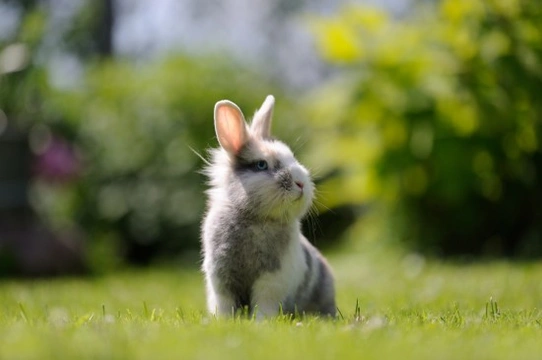
How to Convert a Garden Shed for Rabbits
If you have a garden shed and would like to keep a rabbit or two as family pets, converting it into a great environment for them to live in is not as complicated as it first sounds. Rabbit hutches tend to be a little on the small side and should only be used as a shelter rather than sole area for a rabbit to live in. However, a garden shed or even a Wendy House, can be turned into a superb living area for pet rabbits and the space they offer ensures your pets never get bored.
The Advantages
There are many advantages to converting a larger shed into a rabbit house, one of which is your pets environment is that much easier to clean out and therefore keep clean. The other being that when the weather is cold or wet, rabbits are inside where it's dry, warm and well away from any drafts.
A shed also provides a good environment to keep hay, straw and feed but you would still need to use metal bins to avoid attracting any rodents which could end up being a real problem.
What to Use as Flooring
To avoid getting the floor wet and therefore causing it to rot, it's a good idea to place a good quality lino on it which will protect the wooden floor from any water spills and urine. You could use rubber matting but by far the cheapest material to use is lino which can be found in various thicknesses and qualities so there's something to suit most people's budget.
You Still Need a Hutch
You still need to place a hutch in the shed, somewhere your bunnies can sleep which is very important because when the weather turns cold, tucked away in a hutch means your pets will stay warmer when they are snuggled up in their bedding.
Where to Place a Litter Tray
Keeping pet bunnies in a well insulated shed, means you can place their litter trays away from the hutch, somewhere that's easier to access which means cleaning them out frequently is never a problem.
Fitting an Inner Wire Door
It's also a good idea to fit an inner wire door on the shed so that when the weather is fine enough, you can leave the outer door open which provides lots of ventilation for your pets. However, you have to make sure the wire door is secure so that your bunnies don't escape and unwanted visitors can't get in.
The All Important Ventilation Holes
Even when the weather is very cold, you still need to provide enough ventilation in the shed. Ventilation holes need to be drilled high up on the walls so that air circulates well inside. Most sheds have windows which allows enough light to get in during the day which is also very important for your bunnies well being.
Insulate Shed Walls
It's also a good idea to insulate the shed's walls and there are several ways this can be done. You can choose to wallpaper them using the type that's used in bathrooms or you might want double panel the walls using good quality wood. The thing you need to bear in mind, is that rabbits like nothing better than chewing on wood and they will do just this if you don't provide them with enough toys or wooden sticks specifically made for rabbits to chew on which you can buy from most pet stores.
Insulate the Roof
You can also insulate the roof to ensure that heat doesn't escape through it during the colder winter months and again, you can either double panel it or use a good quality bathroom wallpaper.
Build a Run on the Shed
The next thing you need to do is build a run onto the shed so that when the weather is fine, your bunnies can play outside. The run needs to be very secure so that unwanted visitors can't get in to harm your pets and they can't escape out of it. Rabbits like cats, can learn how to use a cat flap so fitting one on the side of the shed is the perfect solution for them to get in and out of their run. The best type of cat flap is a secure lockable design which means you know nothing can get in or out when the flap is locked.
A Converted Shed Makes a Lovely Garden Feature
Not only is a shed a great place for rabbits to live in, but it can also become a real feature in a garden. Placing plant pots around the run provides a little shade for your bunnies and they look very attractive. However, you need to make sure any plants you place around the run are not toxic to rabbits.
Creating a lovely environment for pet rabbits to live in can be a lot of fun and something the whole family can be involved in. A converted garden shed provides the perfect foundation to build on and as long as it's well insulated, your pets will be nice and warm during the colder winter months. However, with a run added on to the side of the shed, when the weather is fine, your rabbits can be outside enjoying the fresh air and sunshine which helps ensure they stay happier and healthier reducing the risk of them developing any diseases.


Rabbit Shedding Patterns and How to Deal With All The Fur

Rabbits shed A LOT! There is always so much fur around. For many people, this is one of those unexpected parts of rabbit care. Sometimes there is just so much fur that it makes you wonder, is this normal? Should a rabbit really be shedding this much?
How much shedding is normal in rabbits? Rabbits will go through at least two big shedding seasons every year, when they shed their summer coat and their winter coat. Many rabbits will also have two other small shedding seasons during the year, and indoor rabbits who don’t get as much natural sunlight may seem to shed all year round.
For the most part, excessive shedding is not something to worry about in rabbits. However, when your rabbit is going through their big shedding seasons, you want to make sure you care for them to prevent a hair build-up in their digestive system.
You’ll also want to be aware of what’s NOT normal shedding behavior in rabbits. Rabbits can have parasites or skin conditions that cause them to lose fur in abnormal ways. You can learn what signs to look out for so you can tell the difference between normal shedding and hair loss that indicates a health problem.
Seasonal shedding patterns
Most rabbits will have seasonal shedding (also called molting). They shed their coat as a way to adjust to warmer and cooler temperatures. This results in rabbits growing a nice, thick fur coat to keep warm in the winter, and then shedding it for a thinner coat in the summer. It means the rabbit can regulate their body temperature to keep from developing hypothermia or heat stroke.
In addition, rabbits will usually have two smaller molting seasons in between the two larger ones. This means that a rabbit will alternately have a big shedding season followed by a small shedding at about three month intervals. The big shedding seasons will inevitably result in a tornado of rabbit fur making its way around your house, but many times the smaller seasons are less perceptible.
Rabbit molting seasons can last anywhere from 2-6 weeks. On the shorter end of this spectrum, you will be dealing with a whirlwind of fluff as your rabbit sheds their entire coat in a very short period of time. If the season last for 6 weeks, then you are more likely to be dealing with a steady stream of fur, but not quite as much all at once. It will start off slow, then ramp up around the middle of the shedding period. The last couple of weeks should see a steady decrease in fur as the rabbit finishes losing their old coat.
In what months do rabbits shed?
Typically the shedding seasons will happen three months apart, but the exact timing will vary a lot depending on where you live. Many factors, such as temperature and amount of sunlight, can let a rabbit’s body know when it’s time to shed their coat.
To know which months would be most normal for your rabbit to shed, think about the weather. What time of year does it start to warm up in your area?
Where I live, the temperature starts to get warmer right around March to April, so that’s when I can expect my rabbit to start shedding her thick winter coat. Then the weather starts to cool down around October to November. So, again, that’s when I would expect my bun to shed her summer coat.

Rabbit appearance during shedding seasons
While most of the time rabbits will have a nice, shiny and sleek coat, rabbits can all of a sudden start to look pretty shaggy during shedding seasons. There will be fur flying with tufts of fur sticking out of the rabbit’s coat, and they will often have an uneven coat color as well. They’ll look so raggedy that if this is your first time experiencing a rabbit molting season, you might wonder if your rabbit is having some sort of health problem.
But after a while, you start to notice a pattern in your rabbit’s shedding. Usually it will start along their forehead and jaw. Your hand will come away with a little bit of fur on it, but not all that much. You may even see a fur line on their forehead that marks the difference between the new and old coats.
As the shedding season continues, the shed line will continue down their back, and then down their sides. This is when you will see the most fur flying around the room. Every time you pet your rabbit, you will see little clumps of fur fall away from your hands.
Sometimes the shedding cycle will get stuck at this point. Their face and back will have changed to the new coat, but the rabbit’s butt and sides will still have thick tufts of fur. If this happens, try to help your rabbit finish shedding their coat by using a fine-toothed comb or flea brush.
Some rabbits really dislike the sensation of being brushed, so you may also have to resort to “butt-plucking.” This is when you sneakily pluck out loose pieces of your rabbits fur while you’re petting them, to help them finish shedding their coat.
Check out my article on rabbit grooming for more detailed information on which tools are best to use when brushing your rabbit.
Instead of having a normal shedding pattern where they lose their coats in a predictable line down their body, some rabbits lose it all at once. This is referred to as a coat blow. It’s not very common, but it happens often enough that it’s worth mentioning.
If a rabbit is losing their coat like this, they will shed big chunks of their fur at a time. It can result in rabbits having temporary bald patches in their coats. If the the fur in the bald patches starts to grow back within a few days (usually a little darker than the fur that was lost), then this is perfectly fine and your rabbit will regrow their coat.
However if the bald patch does not start to regrow fur or looks red and irritated, then this is likely a sign of illness in your rabbit. If you have any doubt, contact your vet for an appointment to make sure your rabbit does not have any underlying health conditions.
Can you stop your rabbit from shedding?
Shedding in rabbits can be annoying at times, but it’s important to remember that this is a natural process in rabbits that cannot be stopped.
You can help keep the fur in your home under control by brushing your rabbit regularly during their shedding season. This will help your rabbit lose their coat more quickly. Otherwise, there is the option of adopting a short haired rabbit, such as a rex rabbit. These rabbits still shed, but it will likely not be as disruptive as the fur from other rabbits.
Young rabbit molting
Young rabbits will have a slightly different shedding pattern since they have not grown their adult coats yet. Baby rabbits have a very soft fluffy coat that will be replaced by a transitional coat when they are around 5-6 months old. You generally won’t notice a whole lot of shedding during this time though, since the bunnies are still growing and won’t need to completely shed their baby coat to grow their transitional coat.
During the next six months to a year, as the rabbit reaches adulthood, the transitional coat will develop into an adult coat. Only after this point will the rabbit start to have their normal seasonal moltings.
This is why rabbit caretakers can often be taken by surprise from how much fur is lost during shedding. Even though they’ve been living with their rabbit for a year, they did not experience the full extent of a rabbit fur hurricane until their rabbit had a full adult coat.

Nesting in female rabbits
Female rabbits who have not been spayed may exhibit nesting behaviors. They will pluck fur from their dewlap, chest and abdomen so that they can line their nest. If you notice bald patches in these areas, pregnancy is the likely cause (or a false pregnancy).
While this is a normal behavior in female rabbits, it should not be seen in rabbits who have been spayed. It is always best to get your rabbits fixed! This will solve a number of behavioral and health problems. Female rabbits, in particular, have an incredibly high chance of developing a reproductive cancer if they are not spayed.
Why does my rabbit seem to be shedding all the time?
Some rabbits will seem to shed all year round instead of in normal seasons. Sometimes this occurs because of either too much artificial light, or not enough natural sunlight. If you keep your rabbit in a room that doesn’t get very much natural sunlight or you keep a fluorescent room light on until late in the night, it can confuse your rabbit’s sense of what time of year it is. This combined with a relatively constant indoor temperature results in a rabbit shedding pretty much year round.
The other reason rabbits might shed all year has to do with genetics. Rabbits born as the result of too much inbreeding can have a problem with their body’s ability to sense the amount of light in a day. This causes the rabbit to shed all year round, since they can’t sense when the right time of year should be.
Shedding all the time is generally not a significant health risk to rabbits, but it may be a little more frustrating for you, the caregiver. Your rabbit will always be shedding, so there will always be fur flying around. There’s not much you can do if your rabbit has a genetic problem, but you may be able to help your rabbit regain a natural seasonal molting if you place them in a room that gets natural light and reduce the amount of artificial light they receive.
When is fur loss in rabbits a problem?
Not all fur loss is the result of a shedding rabbit. Sometimes it can be the result of a much bigger health concern. Many of these health problems will involve bald patches. However since rabbits can sometimes lose fur in big clumps, bald patches are not always the most accurate symptom to look out for.
Symptoms that will likely be occurring along with fur loss and bald patches include:
- Crusty skin
- Inflammation
- Excessive itching
Read more about when rabbit fur loss is abnormal

Fleas and mites and ringworm
Parasites like fleas and mites, or fungal infections like ringworm are a possible culprit for abnormal fur loss in rabbits. The good news is that most of these infestations are easily treatable with some simple medications. Talk to your veterinarian to diagnose the problem and for instructions on which medications to use that are safe for rabbits.
There are a few different types of mites that can infest a rabbit. Ear mites and mange will cause fur loss and painful crusting skin around the rabbits eyes, nose and ears. The skin will also be inflamed and more prone to infection.
Another type of mites, known as fur mites, has a much more subtle effect. These will cause a condition that will look like flakes or dandruff on the skin. It may also cause bald patches and excessive itching in rabbits. (Learn more about ear mites in rabbits)
Fleas are usually not as obvious a problem as mites. In small amounts, fleas will be difficult to detect at all. However, a severe flea infection will cause significant itching and scratching, which will eventually lead to fur loss in the rabbit. (Learn how to prevent and treat fleas)
Ringworm
Ringworm is a fungal infection that affects many different species, not just rabbits. It looks like a round bald patch in the fur with slightly irritated skin. Ringworm in rabbits can also cause some small red bumps. It’s important to talk to your veterinarian to get a medication to use for your rabbit. The creams that humans can use to help with ringworm are not safe for rabbits.
Saliva burn
If your rabbit is losing fur only on the area under their chin and on their chest, it may be the result of saliva burn. This is when a rabbit is drooling, causing the area under their chin to be wet all the time. Wet fur and skin can cause a lot of irritation and itchiness, which will result in fur loss, rashes, or sores.
Saliva burn is caused by dental problems in rabbits . Ordinarily, healthy rabbits do not drool at all. But when they have health problems, such as overgrown teeth, then the rabbit will not be able to close their mouth correctly. This ends up leading to a lot of drool, which irritates the skin under their chin.
Other symptoms of saliva burn include a change in eating habits. Since the rabbit is experiencing some dental issues, they will struggle to eat as they usually do. You may find that your rabbit refuses to eat any hay at all, or is constantly dropping food out of their mouth.
Urine scald
Urine scald occurs on the underside of a rabbit and around their hind legs when rabbit pee collects on the fur and skin. Like with saliva burn, this will eventually cause irritation and rashes to occur on the skin in that area. This is usually caused by a urinary tract infection or similar conditions that cause the rabbit to dribble urine down their legs.
Urine scalding can also be the result of rabbits who are unable to clean themselves properly. Rabbits who are disabled, obese or elderly, may not be able to reach to clean their backside after they urinate.
This condition can also be the result of a rabbit spending too long in an unclean environment. Rabbits who live in enclosures that are never cleaned, will end up being forced to sit in their own waste, eventually causing painful scalding on their whole underside. I’ve seen this a lot in rabbits who end up at an animal shelter after months of neglect.
Skin infection
Rabbits can also contract a bacterial skin infection that will cause fur loss. This is more likely to occur in rabbits that live in humid climates, since excess water on a rabbit’s fur can lead to irritation and infection. An infection can also result from a minor injury or cut, so it’s best to keep an eye on any damaged skin closely to make sure there aren’t any further health complications.
Overgrooming
Sometimes fur loss will be the result of overgrooming. This can be a rabbit grooming themself too much, or a rabbit grooming their bonded partner too much. Whichever case, overgrooming is not a normal behavior. It is usually a sign of boredom or stress in rabbits. Other than fur loss, there are usually not many other symptoms present, so unless you can watch your rabbit’s behavior very closely, it may be difficult to diagnose.
If you believe your rabbit is too stressed, try moving them to a quiet and calm environment so they won’t be scared all the time. If your rabbit is bored, try to make sure they get more time out to explore and exercise. You’ll also want to make sure their enclosure is big enough , since many rabbit cages sold in pet stores are too small for rabbits .
Giving your rabbit a variety of toys will also help keep them occupied during the day. Buy some wooden and natural toys, or try your hand at some DIY rabbit toys.
Rabbits that live together can potentially fight each other. Even rabbits that used to get along, can turn on each other or have a short scuffle. When that happens, fur will go flying. But if it happens while you’re not looking, you may only see the resulting bald patch on one of the rabbits.
If you believe your rabbits may have gotten into a scuffle, check them over for any cuts or scabs. Often this in-fighting can occur as young rabbits reach maturity. It’s important to spay or neuter your rabbit to prevent any future violent behavior.
How to prevent hairballs
Rabbits will lick themselves to stay clean. This means that during a heavy shedding season, your rabbit will inevitably be ingesting a lot of fur. For a healthy rabbit, this is okay because the fur will be able to make its way all the way through the rabbits digestive system.
However, if your rabbit is ill or does not have a healthy diet , all that fur could end up forming a blockage in your rabbits stomach or digestive tract. Since rabbits cannot vomit to get the hairball out of their system, this can quickly become a very dangerous condition for the rabbit.
To help your rabbit’s digestion run smoothly and prevent hairballs:
- Provide fresh water: Your rabbit should have plenty of fresh water every day. It’s a good idea to use a water bowl instead of a water bottle because it’s more natural for rabbits to drink from a bowl. This will encourage them to drink more.
- Provide fresh hay: Rabbits should always have access to unlimited hay. The high fiber content in hay keeps their digestion running smoothly.
- Brush your rabbit frequently: This will help to remove some of the excess fur so your rabbit won’t be eating quite as much of it.
- Keep an eye on their poop: When rabbits start to ingest a lot of fur, you will start to see it in their poop. Their normal fecal droppings will be linked together by strands of fur. If you notice a lot of these linked poops, you will want to brush your rabbit more frequently so that they are eating less fur.

While your rabbit is going through a heavy shedding period, you will need to brush them more often. If your rabbit is experiencing a particularly fur-filled shedding season, you will probably need to brush them on a daily basis. However, rabbits that have a longer or lighter molting might only need to be brushed once a week.
Pay attention to the appearance of your rabbit to know how often you should brush them. If they have a very ragged coat, with tufts of fur sticking out everywhere, they probably need to be brushed more frequently.

What if my rabbit hates to be brushed?
Rabbit have very sensitive skin, which means many of them hate being brushed. You will need to experiment with different brushing tools to find one that your rabbit will tolerate. Some tools that I’ve tried are:
- A flea comb
- A fur-buster comb
- A fine toothed comb
- A glove brush
- A rubber brush
- A lint roller
If you absolutely can’t find something that works, then you’ll need to resort to petting with your hands and plucking the excess fur off of your rabbit. This isn’t ideal, since you won’t be able to get a lot of the loose fur, but it’s a possibility for those rabbits who won’t put up with anything else.
Learn which grooming tools are best to use for your rabbit depending on their fur type and skin sensitivity.
How to keep a clean house when your rabbit is molting
When a rabbit is shedding, their fur will get everywhere . It can be difficult to keep a clean house. Fur will make its way into all the nooks and crannies. You find it on your clothes and you’ll even find it up your nose (seriously!). Some of the steps I take to keep my living place as clean as possible during a big shedding season include:
- Lint brush: Always have a lint brush available, and wait until you are about to walk out the door to use it.
- Frequent vacuuming: Fur will collect on carpets and rugs, so if you don’t vacuum often, then just sitting down will end up spreading fur around.
- Clean off ceiling fan blades: Ceiling fans will collect flying fur on the blades and then disperse it throughout the room. Regularly cleaning the blades off will keep the fur from building up.
- Check AC and heater filters: AC units and heaters often have filters to catch dust particles. These will quickly fill up with rabbit fur and you’ll need to clean them out for them to work efficiently.
- Keep your rabbit out of the kitchen: Unless you like to eat rabbit fur, it’s best to keep your rabbit out of the kitchen completely. Consider installing a doggy gate along the entrance to keep your rabbit out.
- Harvey, Carolynn DVM. “Grooming.” House Rabbit Society . https://rabbit.org/care/grooming-handling/grooming/.
- Krempels, Dana Ph.D. “Fur Loss and Skin Problems in Rabbits: Common Causes and Treatments.” University of Miami Biology Department. http://www.bio.miami.edu/hare/furloss.html.
- “Moulting.” Rabbit Welfare Association and Fund . April 2017, https://rabbitwelfare.co.uk/rabbit-health/moulting.
- Praag, Esther vaan Ph.D. “Varying Shedding Patterns Among Rabbits.” Medirabbit . http://www.medirabbit.com/EN/Skin_diseases/Molting/Shedding1.htm.
- Stephen White, Ron Rees Davies, David Scarff. “Molting Patterns: Normal and Abnormal.” Vetstream . https://www.vetstream.com/treat/lapis/freeform/molting-patterns-normal-and-abnormal.
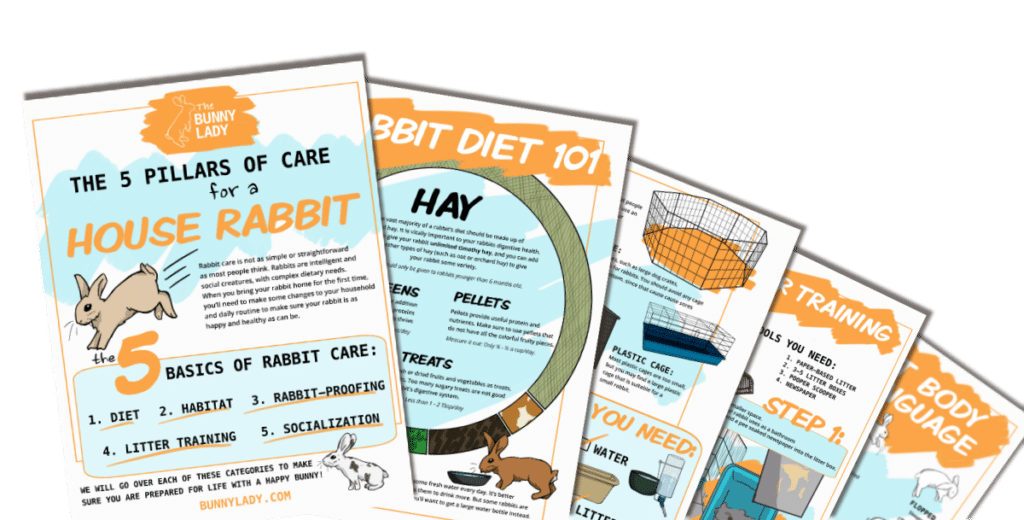
Tips and Tricks Newsletter
If you are new to caring for rabbits, check out the Bunny Lady bimonthly newsletter. Right after you sign up, you’ll receive a FREE pdf rabbit care guidebook. I put together a guide that goes over all the basics of rabbit care so you have it all in one place. Then you will receive tips and tricks about rabbit care straight to your inbox so that you know you’ll be taking excellent care of your new rabbit.
Recommended Products and Brands
Important: These are Affiliate links. As an associate to Amazon, Small Pet Select, and Chewy.com, I may receive a small commission from qualifying purchases.
The two brands that I use when buying food for my rabbit are Oxbow and Small Pet Select . These both have high quality rabbit products and are companies that care about the health of our small animals. If you are purchasing anything from Small Pet Select use the code BUNNYLADY at checkout to get 15% off your first order.
- Hay: Second Cutting Timothy Hay from Small Pet Select
- Read more about why I recommend Oxbow rabbit food
- Treats: Oxbow Simple Rewards
- Toys: Small Pet Select Natural Toys
- Learn why this is so much better than a traditional rabbit cage.
- Read more about why I recommend this product .
Amy Pratt is a lifelong rabbit owner who has been specializing with rabbits at the Humane Rescue Alliance. She helps to socialize the rabbits and educate volunteers on the care and behavior of these small mammals.
Recent Posts
17 Basic Care Tips for Indoor Rabbits
Rabbits are wonderful indoor pets with adorable mannerisms and playful personalities, but there are some challenges that come with bringing a rabbit home for the first time. From making sure your...
How to Make a Bunny Burrito (step-by-step)(for pet rabbits)
It’s time to get in the kitchen and learn how to make a yummy, veggie burrito for your bunny. Just kidding! A bunny burrito is a technique where you wrap your bunny in a towel in a way...

325 Wisconsin COURT S, Saint Petersburg, FL 33705
1252 sq.ft · 3 bedrooms · 2 full baths, enter your information to receive updates on this property, successfully submitted.
- 325 Wisconsin COURT S
- 2 Full Baths

Mortgage Calculator
Additional media.
120 81st Avenue Ne, Saint Petersburg, FL 33702
Single Family
David Adkins
Fisher & Associates Real Estate
Last updated:
August 20, 2024, 05:30 PM
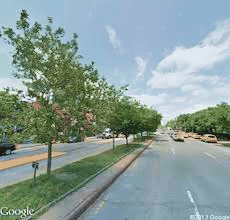
About This Home
Welcome to Rio Vista, one of St. Petersburg's most sought-after neighborhoods. This charming community offers a prime location near Weedon Island and Riviera Bay, perfect for outdoor enthusiasts who enjoy fishing, canoeing, and other recreational activities. With close proximity to dining, shopping, beaches, major roadways, and Downtown St. Petersburg's vibrant attractions, this home is ideal for those seeking both convenience and a serene lifestyle. Situated on a spacious corner lot, this property offers an ample backyard perfect for family gatherings and outdoor enjoyment. Dive into the inviting saltwater pool, featuring a new cell and computer system installed less than six months ago, an 8.5-foot depth, 16 x 33' long and stunning pebble-tech and shell interior finish. As you step inside, you'll be greeted by beautiful double doors leading into a thoughtfully designed interior. The family room, complete with a cozy fireplace, provides a perfect space for relaxing on cooler nights. The kitchen offers ample countertop space and a clear view of the dining area and backyard, making it perfect for both cooking and entertaining. The master bedroom is a nice retreat featuring double doors that open to the pool area, a remote-controlled ceiling fan, a cedar walk-in closet, and newly remodeled En-suite bathroom with a teak wood sink. A second guest bathroom has also been recently updated with modern finishes. Additional highlights include fresh interior and exterior paint, a roof replaced just three years ago with durable modified bitumen, a two-car garage, and large Quonset hut shed in the backyard. This home is move in ready yet offers endless possibilities for personal touches. Don't miss this fantastic opportunity to own a piece of Rio Vista's charm!
Built in 1956
Price Summary
$405 per Sq. Ft.
Last Updated:
3 day(s) ago
Rooms & Interior
Total Bedrooms:
Total Bathrooms:
Full Bathrooms:
Living Area:
1,872 Sq. Ft.
Building Area:
2,412 Sq. Ft.
Year Built:
Lot Size (Sq. Ft):
Finances & Disclosures
Price per Sq. Ft:
Contact an Agent
Yes, I would like more information from Coldwell Banker. Please use and/or share my information with a Coldwell Banker agent to contact me about my real estate needs.
By clicking Contact I agree a Coldwell Banker Agent may contact me by phone or text message including by automated means and prerecorded messages about real estate services, and that I can access real estate services without providing my phone number. I acknowledge that I have read and agree to the Terms of Use and Privacy Policy.

IMAGES
COMMENTS
Tour of the Rabbit Shed/Bunny Barn | June 2022An updated tour of the converted rabbit shed/garage - home to my 4 bunnies :) Website: www.erinsark-petcaregui...
Rabbits Bunny Colony homestead Rabbitat Bunnies Rabbit house habitat Canadian nature.This is a continuation of the bunny barn and rabbitat build. In this epi...
Updated rabbit shed tour_ August 2014 AND a huge suprise for you subscribers Make sure you leave us a comment or a thumbs up if you enjoyed this video. Keep ...
A basic rabbit shed which includes an existing hutch inside a secure rabbit run will cost on average $300. A walk-in all-in-one rabbit shed that includes a rabbit run area will cost on average $750 if you build it from scratch. Converting a garden shed will cost about $300, assuming the garden shed was free. Cost To Buy A Rabbit Shed
Benefits a Rabbit Shed. Size - Sheds are bigger than hutches, and bigger is better when it comes to rabbit accommodation. A sheds provides plenty of room for toys and activities; the height allows for boxes and shelves for your rabbit to hop on and off. Easy to adapt - Although some owners go all out creating sheds with insulation, heating and ...
Let's just start with a reminder of our minimum size guidelines: A single enclosed area of at least 3m x 2m by 1m high. This is for 2 average sized rabbits, so if you have giant breeds you will need to increase that. If the shed is smaller than 3m x 2m shed to convert then you will still need to attach a permanent exercise run to it.
According to the Rabbit Welfare Association & Fund (RWAF) a hutch alone is not enough. Rabbits require a large amount of space, a minimum of 3m x 2m x 1m for 2 average-sized rabbits. If your shed is smaller than 3m x 2m your rabbits will also require the addition of a permanent exercise run. Therefore, if you're thinking about buying a rabbit ...
Rabbit Care Help & Advice. Housing. My Rabbit Shed Tour. Thread starter Mischief and Tinker's Mum; Start date Feb 18, 2014; M. Mischief and Tinker's Mum Wise Old Thumper ...
Connect them using a tubing or tunnel system. Visit RunAround for inspiration. Attach the run directly onto the shed or Wendy house using suitable wood screws and create a hole between the shed and run. Make sure this is big enough for your pet rabbits to easily walk through. Place the shed or Wendy house within a secure aviary, creating a hole ...
All the details - in the plans! 30" deep x 7-feet long - allows for more exercise. Built with wire on the inside, so rabbits can't chew the structural wood. No wood under the floor wire, meaning no buildup of waste in the corners. Bonus - stable shelf area to jump up on for enrichment. Den area for hiding and getting out of the weather.
Hi everyone! Here is a video of building the new bunny shed and a quick tour of their current set up :) I'm so excited that it is finally finished and there'...
Rabbit shedding and cat shedding share some similarities but also have some differences. Both rabbits and cats naturally shed their fur; however, rabbits typically experience more distinct shedding seasons, while cats shed all year round. Also, rabbit fur is generally finer and lighter, which may cause it to become airborne more easily compared ...
Again, much like a playhouse, sheds will need some work to convert them into rabbit accommodation. Sheds and large playhouses need a smaller enclosed sleeping area inside, such as a small hutch or sleeping box. Cost: 6'x4' shed £150 + 6'x4' rabbit run £60 Total 72 square feet, £2.92 per square foot. More information on sheds. Aviary
Build a Run on the Shed. The next thing you need to do is build a run onto the shed so that when the weather is fine, your bunnies can play outside. The run needs to be very secure so that unwanted visitors can't get in to harm your pets and they can't escape out of it. Rabbits like cats, can learn how to use a cat flap so fitting one on the ...
This is when a rabbit is drooling, causing the area under their chin to be wet all the time. Wet fur and skin can cause a lot of irritation and itchiness, which will result in fur loss, rashes, or sores. Saliva burn is caused by dental problems in rabbits. Ordinarily, healthy rabbits do not drool at all.
Zillow has 2 photos of this $517,500 3 beds, 2 baths, 1,507 Square Feet single family home located at 1740 51st St N, Saint Petersburg, FL 33710 built in 2007. MLS #U8254110.
mini rabbit shed tour because every rabbit deserves the best🤎🐰 🐰 rabbit canvas from @wrendaledesigns 🐰 blankets & bowl from @asda 🐰 large wooden box from @ikeauk! 🐰 wood personalised ornaments from @thecraftygiraffe 🐰 hay from @haybox.club to think of these wonderful animals in labs in cages having products put into their eyes and skin for our benefit having no quality of ...
The Bunny shed is finally finished! 00:00 intro 00:58 Decluttering toys05:25 Tidying up 05:40 Painting 06:04 Changing the dig box 07:09 Before and After 07:3...
MLS #: U8253520. Welcome to your dream bungalow in the highly sought-after Old Southeast neighborhood of St. Petersburg! Built in 2017, this 3-bedroom, 2-bathroom gem spans 1,252 sq. ft. and offers a perfect blend of modern comforts and classic charm. The open-concept floor plan, high ceilings, and abundant natural light create a warm and inviting atmosphere.
Zillow has 1 photo of this $325,000 2 beds, 1 bath, 600 Square Feet single family home located at 3821 31st St N, Saint Petersburg, FL 33714 built in 1949.
Rabbit Shed Tour 🐰 | February 2020-----New Lifesty...
Zillow has 23 photos of this $325,000 2 beds, 1 bath, 744 Square Feet single family home located at 766 71st Ave N, Saint Petersburg, FL 33702 built in 1965. MLS #T3550724.
Find Property Information for 120 81st Avenue Ne, Saint Petersburg, FL 33702. MLS# T3550211. View Photos, Pricing, Listing Status & More.
Finally, I've uploaded a shed tour yay! :D It took 3 hours to upload. :( Enjoy and please 'like' the video. :)My facebook page - https://www.facebook.com/pag...